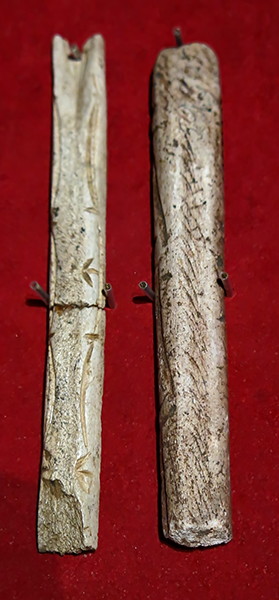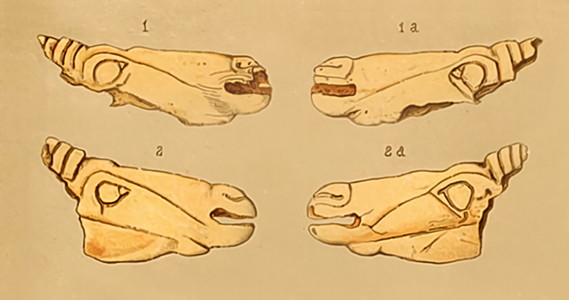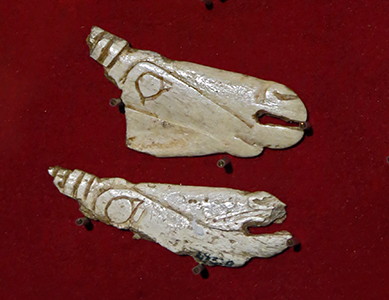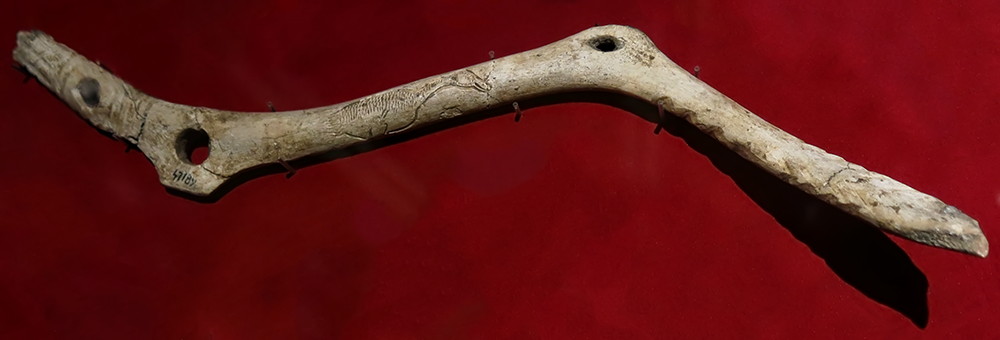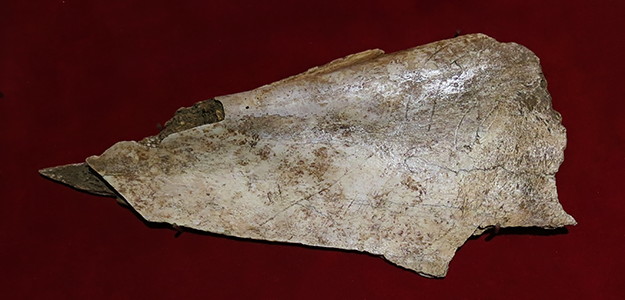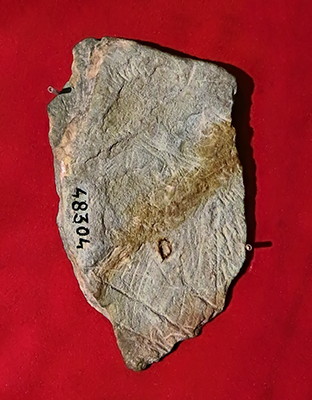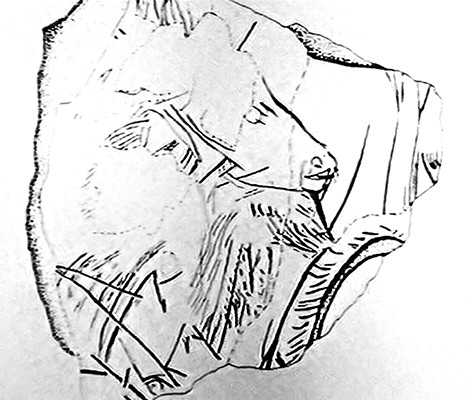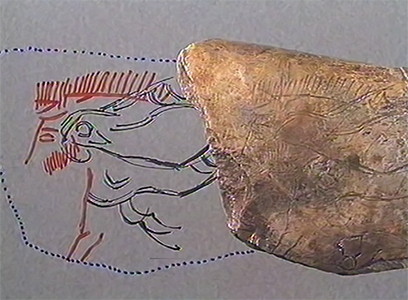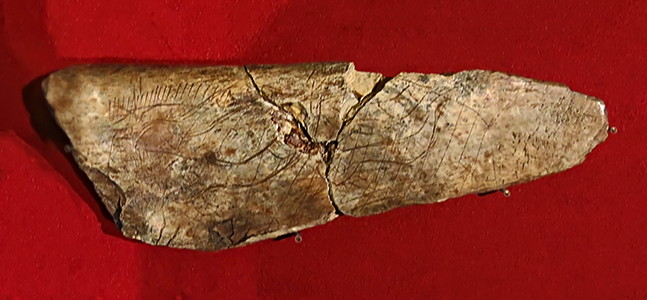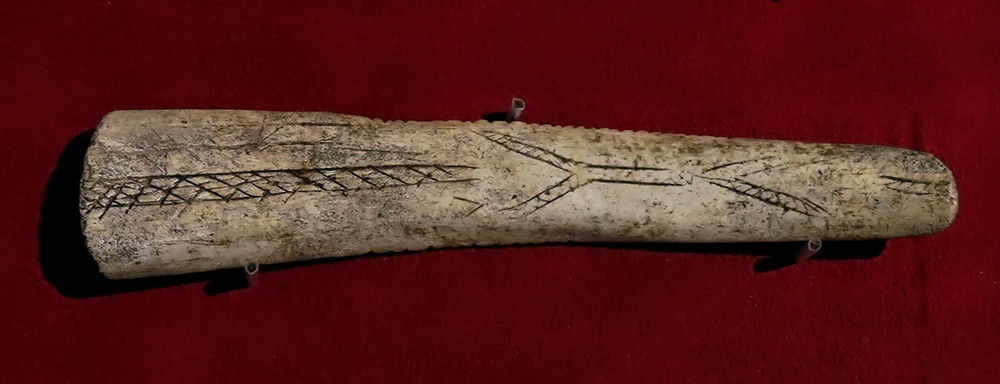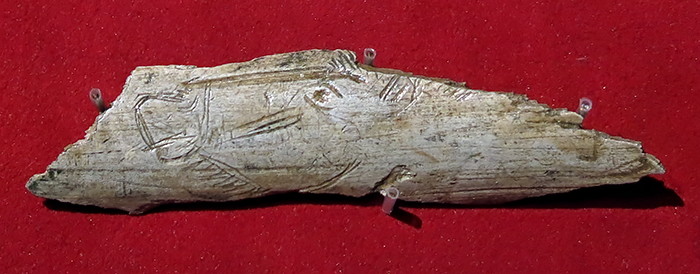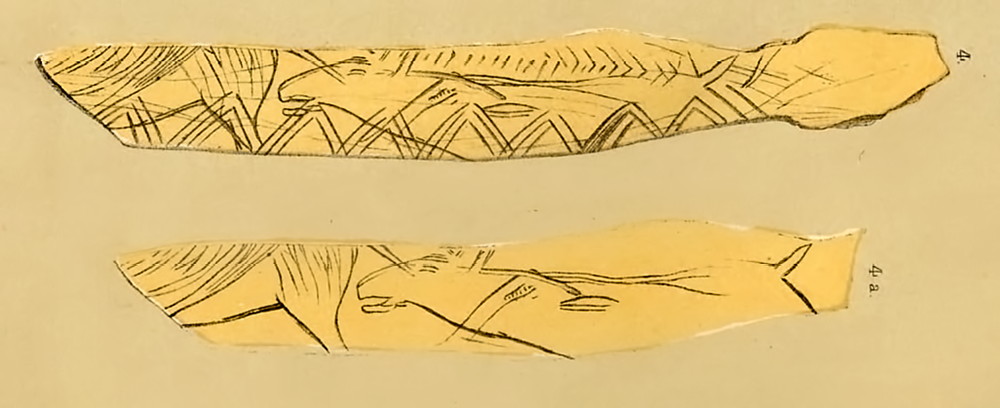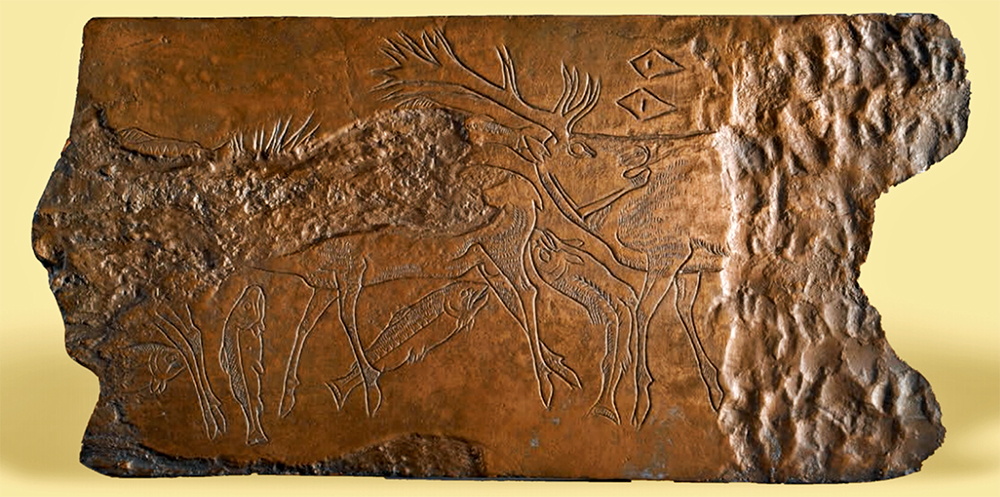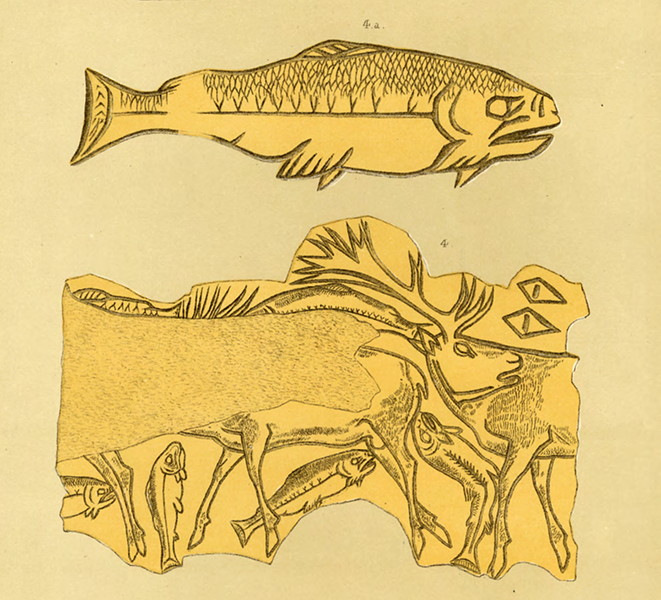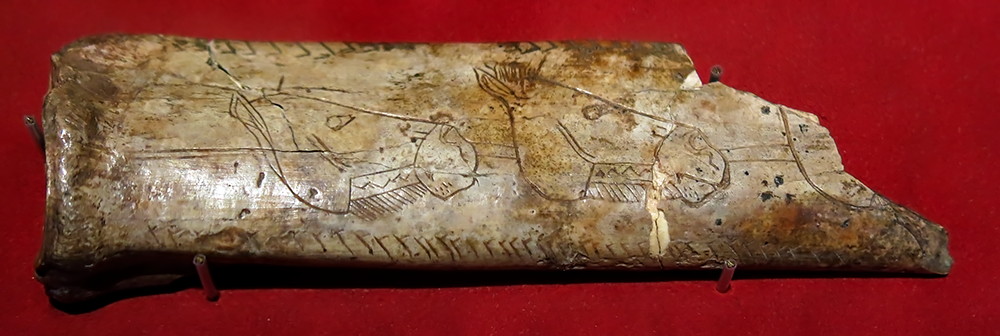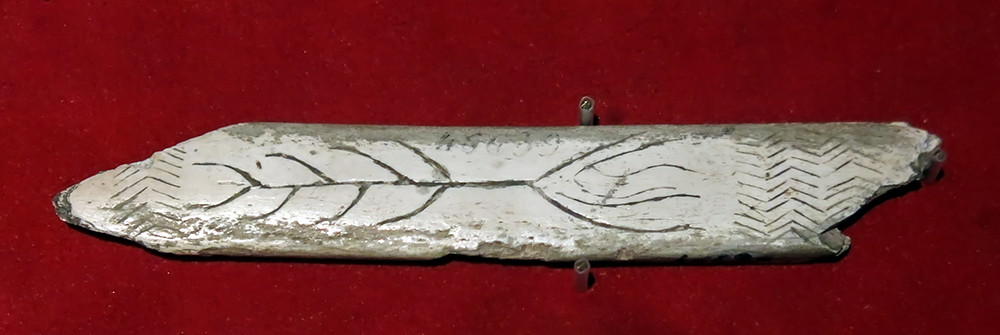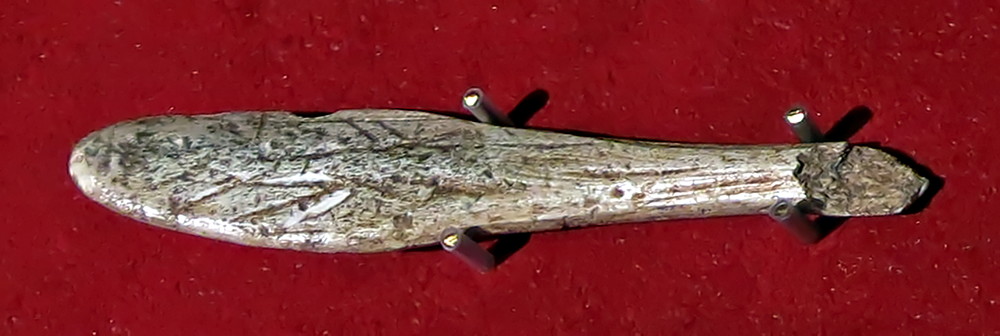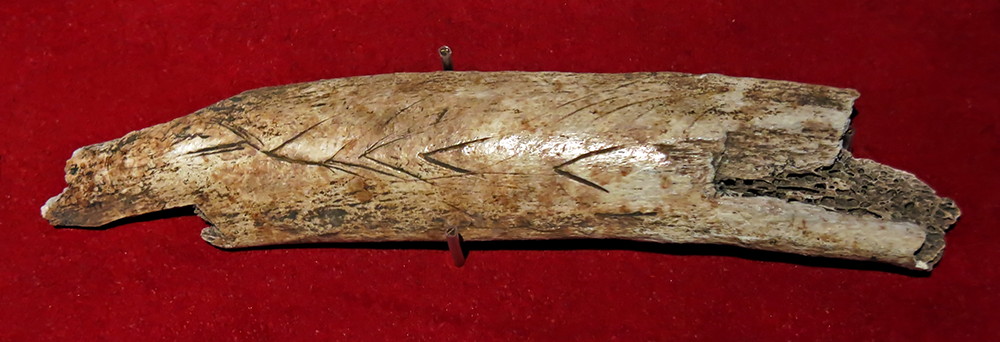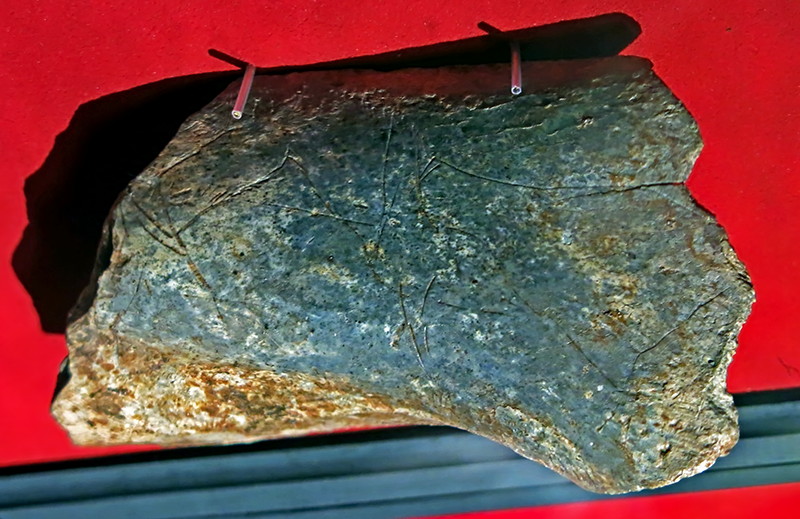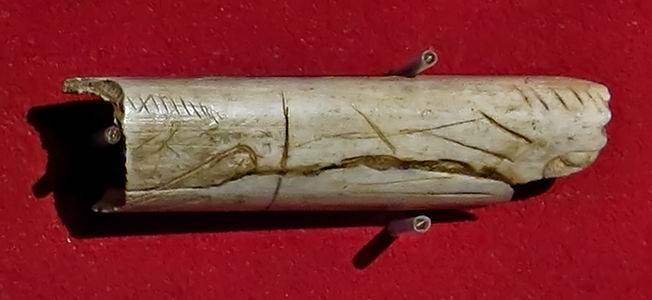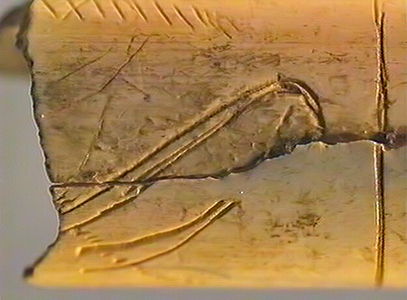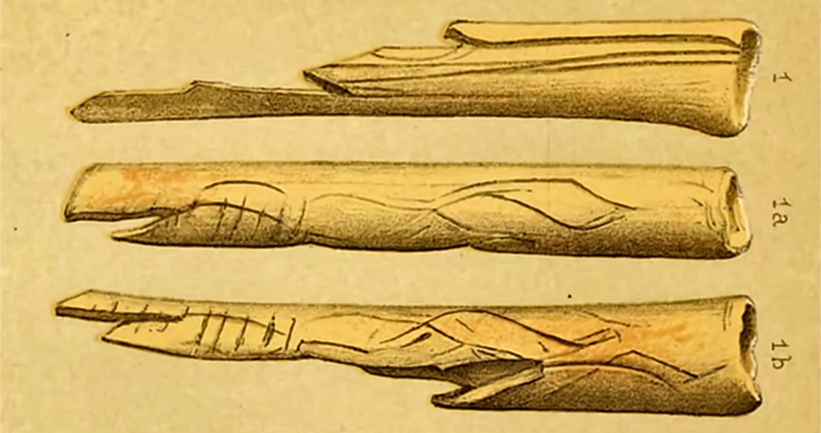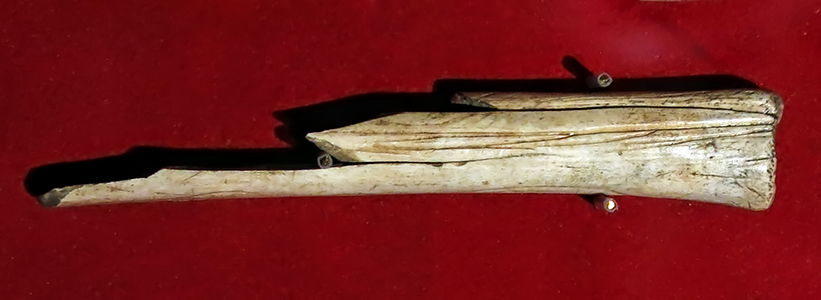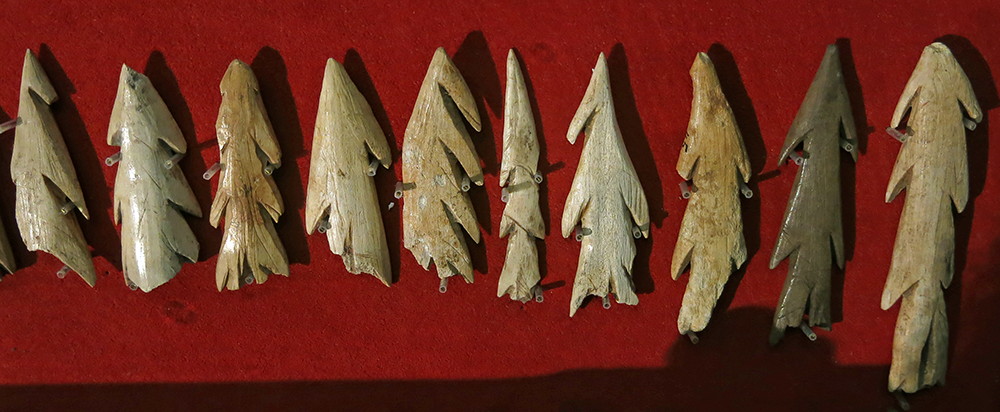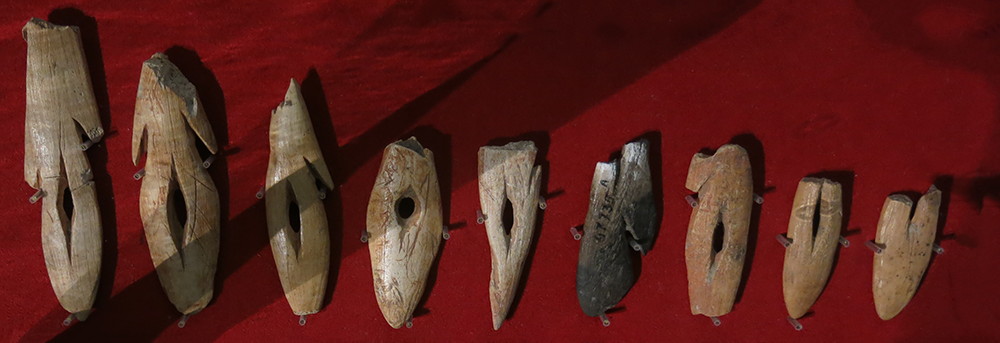Back to Don's Maps
 Back to Archaeological Sites
Back to Archaeological Sites
La Salle Piette
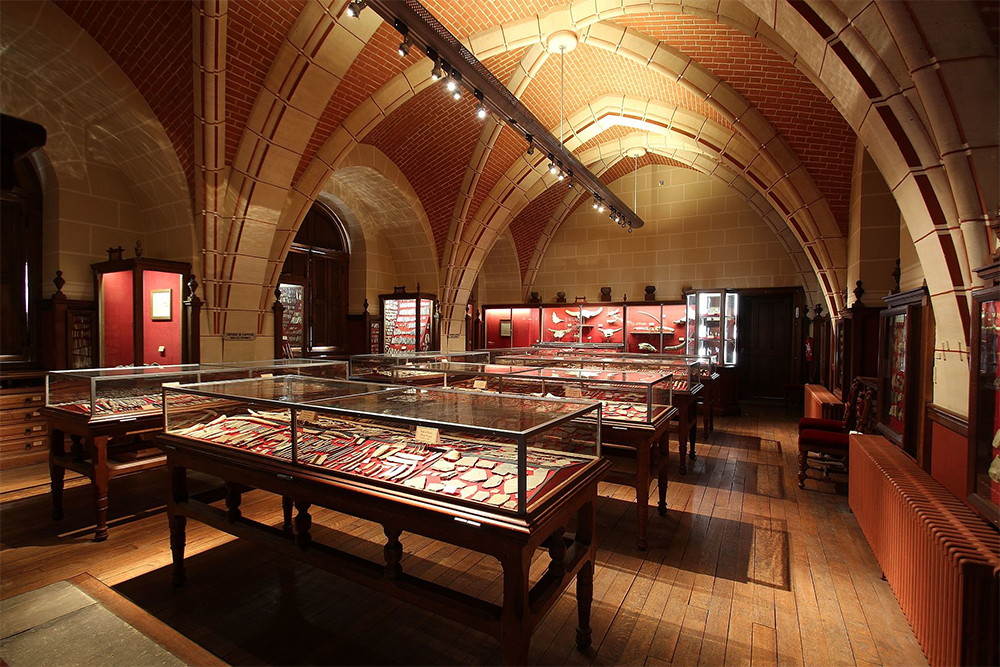
La Salle Piette
Photo: Lionel Allorge
Permission: GNU Free Documentation License
La Salle Piette contains a fabulous collection of prehistoric artefacts, tools and weapons discovered in the 19th century by Édouard Piette during excavations in the Pyrenees. Many masterpieces are exhibited, including several famous 'venus' figures. The set design is unchanged since the 19th century at the express request of Edward Piette who bequeathed his collection to the state on conditions defined by him, and unchanging over time.
Text above: Adapted from http://musee-archeologienationale.fr/evenement/la-salle-piette-0
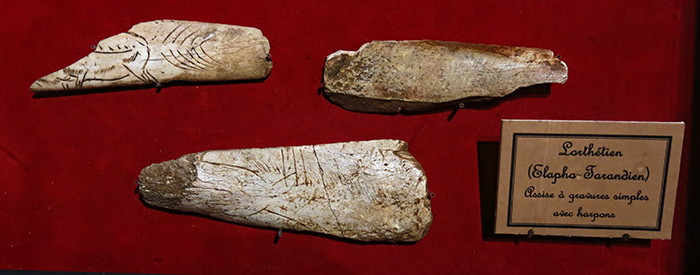
Engraved bones.
The Lorthétien (after the cave of Lorthét (Lortet) which he excavated) was one of the periods which Piette used to divide the Palaeolithic, a schema never adopted by others. Piette defined it as being characterised by engravings, particularly on reindeer antler or bone, or as the label here says, based on simple engravings, and harpoons.
Photo: Don Hitchcock 2015
Source: Original, La Salle Piette, Musée d'Archeologie Nationale et Domaine, St-Germain-en-Laye

Engraved bone showing a reindeer doe with the characteristic spots of 'Pepper's patches'. These occur mostly on young and on female reindeer.
Photo: Don Hitchcock 2015
Source: Original, La Salle Piette, Musée d'Archeologie Nationale et Domaine, St-Germain-en-Laye

Closeup of the engraved bone above, from the Upper Magdalenian, Grotte de Gourdan, Gourdan-Polignan, Haute-Garonne.
On one side, there remains the posterior half of a beautiful engraving of a reindeer. The animal is walking, and the legs are clearly visible. Behind the reindeer, five large interlocking chevrons have been engraved.
100 mm x 26 mm.
Catalog: 47307
Photo: Don Hitchcock 2015
Source: Original, La Salle Piette, Musée d'Archeologie Nationale et Domaine, St-Germain-en-Laye
Text: © musée des Antiquités nationales, © Direction des Musées de France, 2000
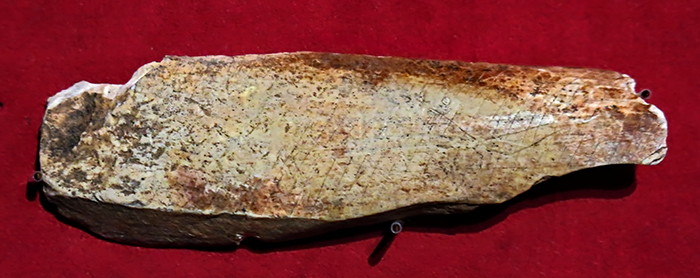
Engraved bone.
Photo: Don Hitchcock 2015
Source: Original, La Salle Piette, Musée d'Archeologie Nationale et Domaine, St-Germain-en-Laye
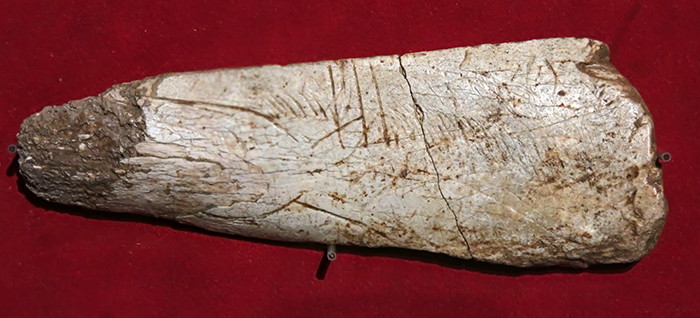
Engraved horse head on bone, from the Magdalenian of Gourdan-Polignan, Layer V.
The shape of the head is confusing but the mane and the neckline are those of a horse. Both ears are erect, the forelock, neck and mane are present. The eye is in an arc.
Dimensions: Length 114 mm, width 40 mm.
Catalog: 48601
Photo: Don Hitchcock 2015
Source: Original, La Salle Piette, Musée d'Archeologie Nationale et Domaine, St-Germain-en-Laye
Text: © Saint-Germain-en-Laye, musée des antiquités nationales, © Direction des musées de France, 2003
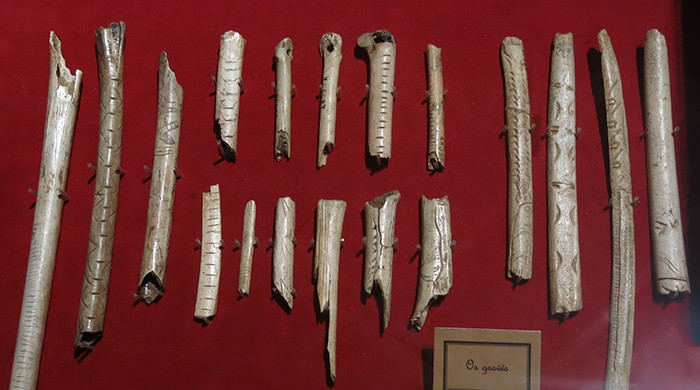
Engraved bones.
Photo: Don Hitchcock 2015
Source: Original, La Salle Piette, Musée d'Archeologie Nationale et Domaine, St-Germain-en-Laye
Engraved bones.
Photo: Don Hitchcock 2015
Source: Original, La Salle Piette, Musée d'Archeologie Nationale et Domaine, St-Germain-en-Laye
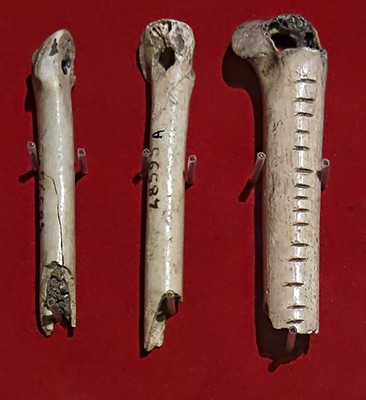
(left)
Perforated bone used as jewellery, Upper Magdalenian, from Gourdan, upper part of Layer V.
Length 64 mm, width 13 mm, thickness 8 mm.
Catalog: 48595 B
(centre)
Perforated bone used as jewellery, Upper Magdalenian, from Gourdan, upper part of Layer V.
Length 70 mm, width 7 mm
Catalog: 48595 A
(right)
Perforated bone used as jewellery, Upper Magdalenian, from Gourdan.
Length 69 mm, width 12 mm, thickness 11 mm.
Distal part of the ulna with transverse parallel lines on one face, the incisions in a v shape.
Catalog: 47429
Photo: Don Hitchcock 2015
Source: Original, La Salle Piette, Musée d'Archeologie Nationale et Domaine, St-Germain-en-Laye
Text: © Saint-Germain-en-Laye, musée des Antiquités nationales, © Direction des musées de France, 2002, 2003
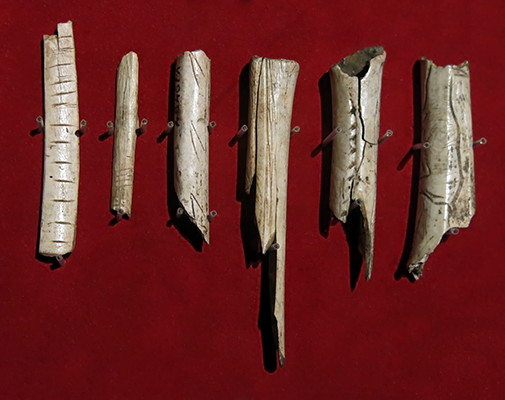
Engravings on bone, the right four on bird bones, the far left on a rib.
Photo: Don Hitchcock 2015
Source: Original, La Salle Piette, Musée d'Archeologie Nationale et Domaine, St-Germain-en-Laye
Engravings on bird bones.
The upper engraved bone is particularly interesting, with engravings of what may be fish or plants.
(Lower) Engraved bird bone from the Magdalenian of Gourdan.
Double broken line inside which have been engraved transverse parallel striations. Zigzag decoration.
Length 169 mm, width 14 mm, thickness 16 mm.
Catalog: 47064
Photo: Don Hitchcock 2015
Source: Original, La Salle Piette, Musée d'Archeologie Nationale et Domaine, St-Germain-en-Laye
Text: © Saint-Germain-en-Laye, musée des antiquités nationales, © Direction des musées de France, 2003

(left) A piece of reindeer antler, flat on one side, convex on the other, at the extremity of which a seal has been engraved.
( while Piette calls this a seal, many now think that this is an auk, a penguin-like bird from the Northern Hemisphere - Don )
Two crescents separate it from two rows of chevrons.
(left centre) Baguette demi-ronde, from the Middle Magdalenian, Gourdan.
Two lateral rows of crescents, some of which are separated by double transverse cuts. Some engravings very worn down on the flat part.
Length 140 mm, width 15 mm.
Catalog: 49340
(right centre) Fragment of a tool in reindeer antler, flat on one side, convex on the other, having, in the middle of the convex face, a strong longitudinal projection, with steep edges. At the bottom of each edge of this projection is a row of parallel lines. The extremities of the instrument present an elegant S-shaped curved line, with signs consisting of diamonds and arcs, which imperfectly resemble the number nine.
(right) Baguette demi-ronde from the Upper Magdalenian, in reindeer antler, from Gourdan.
At one end, a transverse cut, and some curved and oblique incisions.
Also towards the bottom, a chevron with a central 'arrow', and next to it, a simple pair of chevrons.
Length 125 mm, width 13 mm, thickness 7 mm.
Catalog: 47437
(bottom right) Baguette demi-ronde, from the Upper Magdalenian, Gourdan, in reindeer antler.
The head of an indeterminate animal has been engraved from the front. The head is elongated and filled with multiple lines of oblique striae and three oblique bars. It ends above with two long ears and perhaps horns, unless it is the mane of a horse. Two small asymmetrical ears seem to have been added on each side. The head is fractured at the muzzle.
Length 40 mm, width 12 mm.
Catalog: 47323
Photo: Don Hitchcock 2015
Source: Original, La Salle Piette, Musée d'Archeologie Nationale et Domaine, St-Germain-en-Laye
Text: © Saint-Germain-en-Laye, musée des antiquités nationales, © Direction des musées de France, 2002
Additional text: Piette (1907)
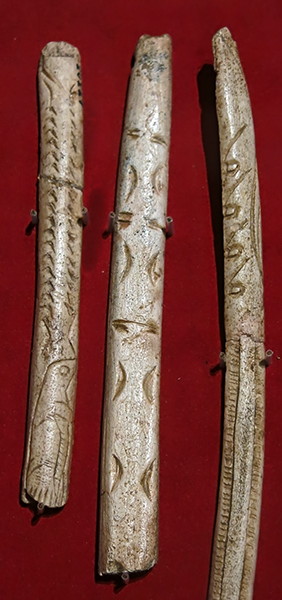
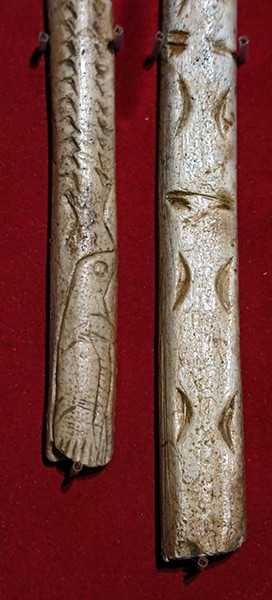
Engraved bones, close ups of some of the pieces immediately above.
Note the engraving of an auk.
Auks are superficially similar to penguins, having black-and-white colours, upright posture and some of their habits. Nevertheless, they are not closely related to penguins, but rather are believed to be an example of moderate convergent evolution. Auks are monomorphic (males and females are similar in appearance).
Auks have largely sacrificed flight, although not to the extent of penguins, and also mobility on land, in exchange for swimming ability. Their wings are a compromise between the best possible design for diving and the bare minimum needed for flying. The feeding behaviour of auks is often compared to that of penguins; both groups are wing-propelled pursuit divers.
Photo: Don Hitchcock 2015
Source: Original, La Salle Piette, Musée d'Archeologie Nationale et Domaine, St-Germain-en-Laye
Text: Wikipedia
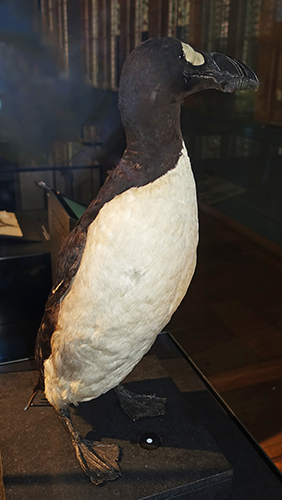
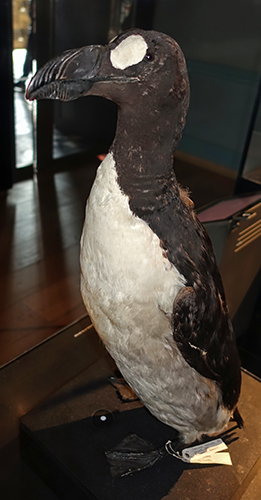
Huge dense colonies of the flightless Great Auk, Pinguinus impennis, shown here once gathered in summer on remote islands off eastern Canada, Greenland, Iceland, and Scotland.
Easy prey for hunters, they were slaughtered in huge numbers until the late 1700s for meat, eggs, feathers, and oil.
European fishermen and whalers devastated the largest colony in Newfoundland. A 1775 petition to stop the massacre failed.
Great Auks have always appealed to humans. A 4 000 year old burial site in Newfoundland contained 200 Great Auk beaks, thought to have been attached to ceremonial clothes.
In the early 1800s, the rarer the birds became the more desirable they seemed until increasing demand from museums and collectors dealt a final and deadly blow.
Photo: Don Hitchcock 2018
Source and text: Original, display at The Natural History Museum, Cromwell Road, London SW7 5BD
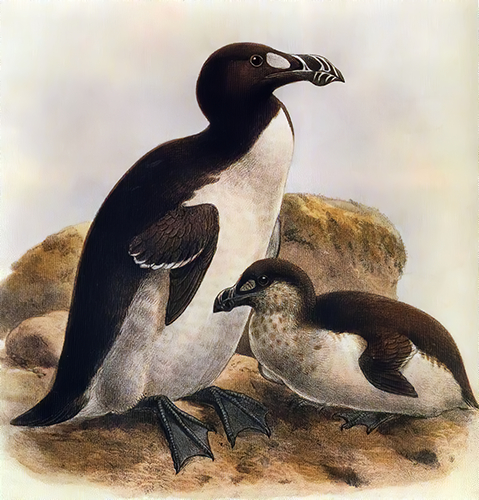
Great auk with juvenile.
Artwork: Great Auks by John Gerrard Keulemans (1842–1912), and commissioned by the 19th century ornithological writer H.E. Dresser.
Proximal source: Wikipedia
Permission: Public Domain
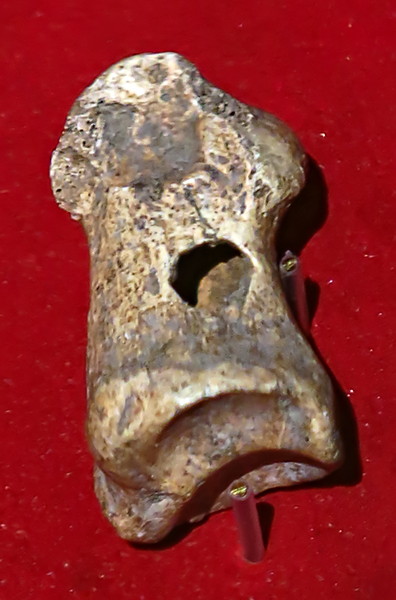
Whistle made from the phalange of a reindeer, pierced on the side. Magdalenian from Gourdan.
31 mm long, 16 mm wide, 11 mm thick.
Catalog: 48572 X1
Photo: Don Hitchcock 2015
Source: Original, La Salle Piette, Musée d'Archeologie Nationale et Domaine, St-Germain-en-Laye
Text: Piette (1907)
Additional text:
© Saint-Germain-en-Laye, musée des Antiquités nationales, © Direction des musées de France, 2003
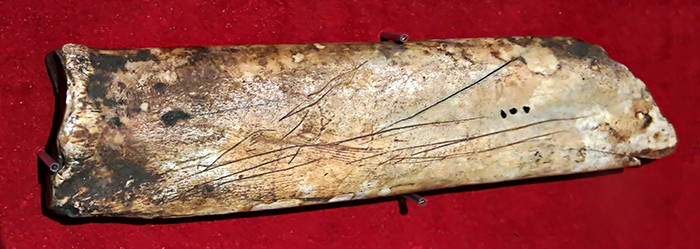
Engraved bone.
Photo: Don Hitchcock 2015
Source: Original, La Salle Piette, Musée d'Archeologie Nationale et Domaine, St-Germain-en-Laye
Top: A découpé pendant of a fish tail, from the middle Magdalenian, from les grottes de Gourdan (Haute-Garonne), from the excavations of Piette, Fourcade, and Bladier, in the campaigns of 1871 - 1874.
38 mm long x 24 mm wide.
Catalog: 47033
Bottom: A découpé pendant of a fish tail engraved with oblique lines, from the middle Magdalenian, from les grottes de Gourdan (Haute-Garonne), from the excavations of Piette, Fourcade, and Bladier, in the campaigns of 1871 - 1874.
51 mm long x 13 mm wide.
Catalog: 47031
Photo: Don Hitchcock 2015
Source: Original, La Salle Piette, Musée d'Archeologie Nationale et Domaine, St-Germain-en-Laye
Text: © musée des Antiquités nationales, © Direction des Musées de France, 2000
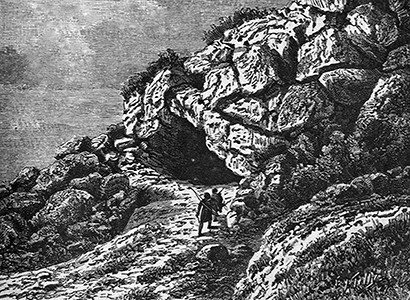
View of la grotte de Gourdan (Haute-Garonne)
Photo: A.E. Tilly
Source: Cleuziou (1887)
(below on right colour photo) Fig. 1, 1a. - Flat bone, carved on two sides in very low relief, representing a well executed ibex head. Collected by Piette at la grotte de Gourdan.
Head of a découpé and engraved ibex with a circular eye, prolonged at one end by the lacrimal caruncle, the small, pink, globular nodule at the inner corner of the eye. It is made of skin covering sebaceous and sweat glands.
The eye is underlined by a line, and we can also note the ringed horn, the snout, the nostril, the open mouth, the chin and the lower jaw.
Dimensions: Length 50 mm, width 16 mm.
Catalog: 47310
Additional text above: © Saint-Germain-en-Laye, musée des antiquités nationales, © Direction des musées de France, 2002
(above on right colour photo) Fig. 2, 2a. Bone carved on both sides with skill, representing an ibex head in flat relief, it is the most successful example of this kind of sculpture. - From the Middle Magdalenian, collected by Piette at la grotte de Gourdan.
Head of a découpé and engraved ibex The eye, nose and mouth are well represented. The mouth is open. It could also possibly be a chamois.
Dimensions: Length 50 mm, width 12 mm.
Catalog: 47052
Additional text above: © Saint-Germain-en-Laye, musée des antiquités nationales, © Direction des musées de France, 2000
Photo (right): Don Hitchcock 2015
Source: Original, La Salle Piette, Musée d'Archeologie Nationale et Domaine, St-Germain-en-Laye
Photo (left) and text: Piette (1907)
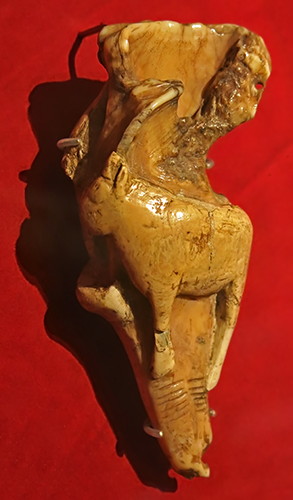

Two Ibex, carved on both sides of the lower tooth of a sperm whale, discovered by Maury. One of the ibex is sideways, and one is longitudinal on the tooth.
The ibex are wrapped around the edge of the tooth, and three perforations were made in the tooth (one of which has been broken out), presumably so that the sculpture could be worn as a pendant. A carved sperm whale tooth is very rare in prehistoric sites. Presumably the whale beached, and the carcass was scavanged for usable items, including this tooth, which was subsequently carried or traded to Mas d'Azil, which is a long way from the sea.
Middle Magdalenian, from Mas-d'Azil, the upstream cavern of the right bank of the river Arise, at the base of the lower gallery.
Pierced tooth with 3 perforations. It is a lower left sperm whale tooth. Two ibexes are carved in relief on the tooth: - on one side, an ibex of left profile, arranged transversely to the longitudinal axis of the tooth, has the snout and the horn fractured. The hind hoof was redone at mid-height.
Below the legs are two sets of six transverse and parallel incisions. On the other side, a long horned ibex, with a straight profile, is arranged longitudinally along the main axis of the tooth. His fore hoof touches the muzzle of the first ibex. Below the hindquarters of the second ibex, a median groove is confined to two series of three oblique and parallel lines, forming interlocking chevrons. The object has three perforations.
The convention of winding around the edges of the tooth was chosen by the sculptor, no doubt to create an elongation of the figures. These figures, however, retain correct proportions. The funnel above the transversal ibex, is the pulp of the tooth. The cavity was shortened by ablation of the edge.
Dimensions: Length 125 mm, width 50 mm, thickness 37 mm.
Catalog: 47257
Photo: Don Hitchcock 2015
Source: Original, La Salle Piette, Musée d'Archeologie Nationale et Domaine, St-Germain-en-Laye
Additional text: © Saint-Germain-en-Laye, musée des antiquités nationales, © Direction des musées de France, 2002

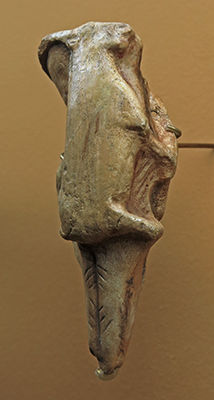
Ibex sculpted on the tooth of a sperm whale.
This view shows the other side of the sculpture, with the ibex shown vertically on the tooth.
Photo: Don Hitchcock 2014
Source: Facsimile, Musée d'Archeologie Nationale et Domaine, St-Germain-en-Laye
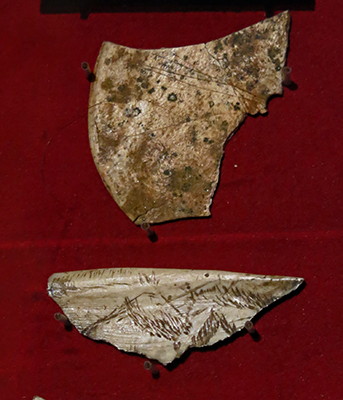
(above) Fragment of a rondelle, with engravings. Probably made from a scapula (omoplate), as most were.
(below) Engravings of the heads of two horses.
Photo: Don Hitchcock 2015
Source: Original, La Salle Piette, Musée d'Archeologie Nationale et Domaine, St-Germain-en-Laye
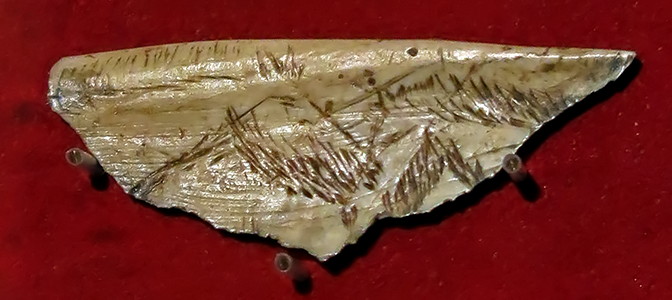
Lissoir, from the Middle Magdalenian of Gourdan-Polignan, Haute-Garonne, layer V.
On one side, a beautiful scene composed of two heads of horses engraved face to face, the two noses seeming to touch as if the horses were sniffing each other.
The first horse is in right profile, it overlaps the second horse. The neck is visible with the mane, the two ears are erect, the forelock is drawn, the eye is engraved with two lines, the forehead is straight, the muzzle, the chin and the lower jaw are covered with hair.
The second horse is in left profile, head bent down, the mane is very full, both ears are erect, the forehead is covered by a forelock, the eye is formed of two incisions, quite long, the muzzle is visible with the nostril, the mouth is fractured, the chin and the lower jaw are covered with a long coat.
On the other side, probably an animal figure of which there remains a line of oblique striae which could be the representation of the coat of a dorsal line, two lines of aligned streaks, and perhaps a fragment of hoof and a tail.
Dimensions: Length 45 mm, width 30 mm.
Catalog: 48603
Photo: Don Hitchcock 2015
Source: Original, La Salle Piette, Musée d'Archeologie Nationale et Domaine, St-Germain-en-Laye
Text: © Saint-Germain-en-Laye, musée des antiquités nationales, © Direction des musées de France, 2003

Engraving of a bovid.
This was created by a master artist. It shows in right profile the two front legs of a bovid, possibly a bison, with a complete and highly detailed left leg and hoof, and most of the right leg.
The ventral line is shown, and the hair of the lower part of the animal and on the legs is shown. This must have been an impressive work when completed.
Photo: Don Hitchcock 2015
Source: Original, La Salle Piette, Musée d'Archeologie Nationale et Domaine, St-Germain-en-Laye
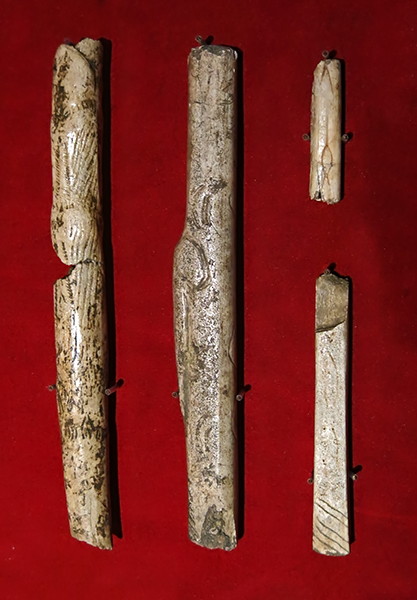
Several bone or antler pieces.
(left) Baguette with sub-parallel striations on the right, linear hatchings down the left, and several arcs in parallel sets on the lower part of the piece.
(centre) Possibly a wedge (ciseau) used to split pre-grooved antler, with a single small bevel on the lower end. On the left, in bas relief, is an object which may be an animal or an anthropomorphic figure. Also evident are several arcuate designs engraved in the surface.
(top right) A small baguette, possibly in mammoth ivory, with two joined ellipses at the base, and a chevron at the top of the piece.
(bottom right) The flat 'underside' of a baguette demi-ronde, used in pairs to hold a flint point at the end of a projectile. At the lower end are several grooves, not intended to be seen, but to act as a key for the birch bark glue used to hold the baguettes demi-rondes together, clasping the point. The other, rounded side, was usually decorated with engravings.
Photo and text: Don Hitchcock 2015
Source: Original, La Salle Piette, Musée d'Archeologie Nationale et Domaine, St-Germain-en-Laye

Spear point, possibly in reindeer antler, beautifully finished.
Photo and text: Don Hitchcock 2015
Source: Original, La Salle Piette, Musée d'Archeologie Nationale et Domaine, St-Germain-en-Laye

(top left) The flat 'underside' of a baguette demi-ronde, used in pairs to hold a flint point at the end of a projectile. At the upper end are several grooves, not intended to be seen, but to act as a key for the birch bark glue used to hold the baguettes demi-rondes together, clasping the point. The other, rounded side, was usually decorated with engravings.
(bottom left) A small baguette, possibly in mammoth ivory, with two joined ellipses at the top, and a chevron at the bottom of the piece.
(centre left) Possibly a wedge (ciseau) used to split pre-grooved antler, with a single small bevel on the upper end. On the right, in bas relief, is an object which may be an animal or an anthropomorphic figure. Also evident are several arcuate designs engraved in the surface.
(centre) Baguette with sub-parallel striations on the left, linear hatchings down the right, and several arcs in parallel sets on the upper part of the piece.
(centre right) Spear point, with arcuate designs on the left edge, and alternating left and right pointing zig zag marks on the right edge.
(right) Spear point, possibly in reindeer antler, beautifully finished.
Photo and text: Don Hitchcock 2015
Source: Original, La Salle Piette, Musée d'Archeologie Nationale et Domaine, St-Germain-en-Laye

Baguette in reindeer antler on which is engraved the head of a deer.
Photo: Don Hitchcock 2015
Source: Original, La Salle Piette, Musée d'Archeologie Nationale et Domaine, St-Germain-en-Laye
Text: Piette (1907)
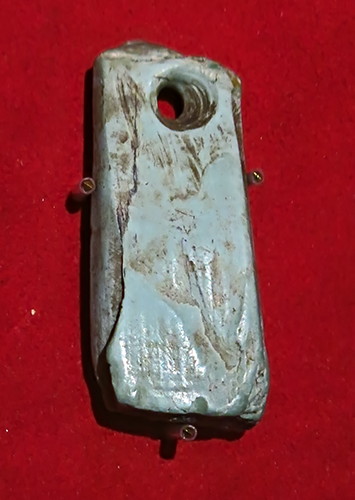
This is a very curious pendant. It is rectangular, for a start, but what is striking is the pale blue colour.
It may be a variety of beryl, which occurs in France, in Brittany at Saint Jacut, but it is very rare otherwise in France, especially in relatively large examples such as this.
The colour extends to the centre of the material, as can be seen in the hole used for a cord. The Magdalenian inhabitants of Mas d'Azil had the ability to drill through stone.
Beryl has only one cleavage plane, basal cleavage (cleavage: {001}) which appears to be the case in this example.
Photo and text: Don Hitchcock 2015
Source: Original, La Salle Piette, Musée d'Archeologie Nationale et Domaine, St-Germain-en-Laye
Additional text: https://en.wikibooks.org/wiki/Identifying_Rocks_and_Minerals/Cleavage
This Middle Magdalenian engraving of bovids on a rib bone from Gourdan-Polignan has been done in a competent, confident manner.
Two heads of bovids engraved head to tail, in profile, and connected to each other by the combination of the dorsal lines and their heads.
Dimensions: Length 71 mm, width 37 mm.
Catalog: 47301
Photo: Don Hitchcock 2015
Source: Original, La Salle Piette, Musée d'Archeologie Nationale et Domaine, St-Germain-en-Laye
Text: © Saint-Germain-en-Laye, musée des antiquités nationales, © Direction des musées de France, 2002
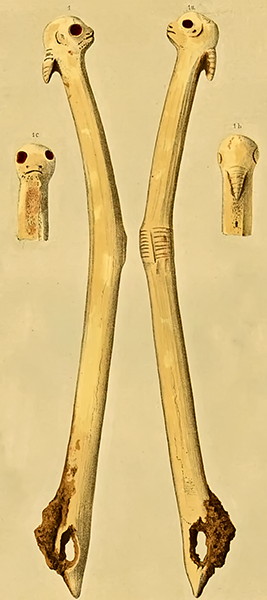

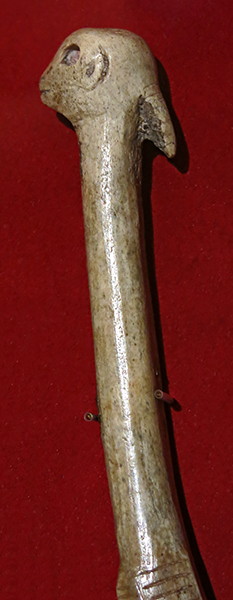
Spear thrower, propulseur, from Grotte de Gourdan-Polignan
This is made of reindeer antler, finished with a rounded head that the artist has finished in a bizarre manner.
The nose and the chin are simian. The mouth consists of a simple slit. It is depressed and scarcely distinct from the nose. The ears are human; the eyes were embedded in two rounded cavities, where they were held by red ochre clay. The clay has remained, but the objects of which the eyes were formed has disappeared.
The hair is pulled back, and is fashioned into a short queue. A monstrously long neck, on which was carved an outgrowth, gives this object, which was perhaps a fetish, an even more singular aspect. The cylindrical rod which forms this neck is pierced at its end with a hole.
The spear thrower is complete, which is a very rare characteristic for this type of object. At the distal end, an anthropomorphic head has been carved and engraved. The orbit of the eye has been dug out and encrusted. The ear, the mouth and the nose are shown. The propulseur hook, marked by transverse lines, seems to represent the hair of the subject. Towards the middle of the shaft and on one side only, a bulge is marked by a double series of eight transverse and parallel lines. The proximal end used for fitting to a shaft is provided with a single bevel and a 'buttonhole' perforation.
Dimensions: 282 mm x 26 mm.
Catalog: 47259
Photo (centre and right): Don Hitchcock 2015
Source: Original, La Salle Piette, Musée d'Archeologie Nationale et Domaine, St-Germain-en-Laye
Photo (left) and text: Piette (1907)
Additional text: © Saint-Germain-en-Laye, musée des antiquités nationales, © Direction des musées de France, 2002

Another photo of the piece, originally in reindeer antler, from the cave of Gourdan-Polignan, showing the well made facsimile displayed in the Musée d'Archeologie Nationale.
Circa 17 000 BP
Dimensions: 282 mm long, 19 mm wide, 26 mm thick, Catalog MAN82126
Photo: Don Hitchcock 2018
Source: Facsimile, Musée d'Archeologie Nationale et Domaine, St-Germain-en-Laye
Text: https://www.photo.rmn.fr/
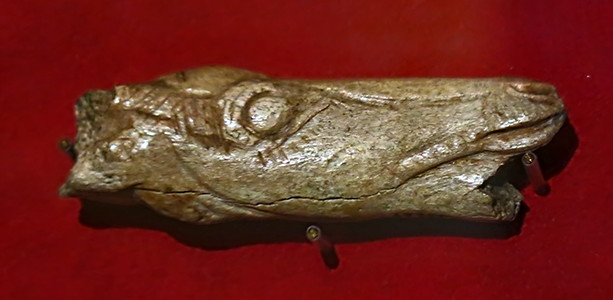
Head of an ibex carved in reindeer antler from Grotte de Gourdan.
The eyes and the mouth are protruding, as are the upper lips, on which the the artist has traced folds that remind us of the teeth they cover. The forehead is slightly convex; the pointed, straight ears point backwards.
The horns are not very thick or rugged and are of rounded section. The beard which originally projected forward has been broken off.
Propulseur, spear thrower, in the shape of the head of an ibex, from the Middle Magdalenian of Gourdan, layer 1.
Very beautiful carved and engraved head. The eye and muzzle in particular are beautifully executed.
Length 56 mm, width 18 mm.
Catalog 47251
Photo: Don Hitchcock 2015
Source: Original, La Salle Piette, Musée d'Archeologie Nationale et Domaine, St-Germain-en-Laye
Text: Piette (1907)
Additional text: © Saint-Germain-en-Laye, musée des antiquités nationales, © Direction des musées de France, 2002

The head as a whole has a cylindrical shape imposed by that of the reindeer antler of which it is made. Despite the description above, it is still one of the most perfect sculptures collected in Gourdan.
Piette suggested it may have been the handle of a knife.
Photo and text: Piette (1907)
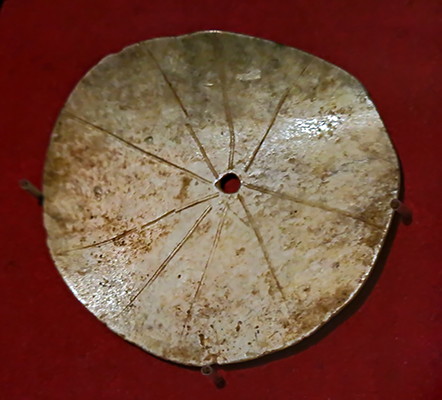
Rondelle, made from a scapula.
They are surprisingly difficult to make, and to get perfectly circular without modern tools, and were possibly used as spindle whorls for spinning yarn.
Photo: Don Hitchcock 2015
Source: Original, La Salle Piette, Musée d'Archeologie Nationale et Domaine, St-Germain-en-Laye
Engraving of a reindeer with antlers, with the muzzle of a horse engraved at one end, upside down in relation to the reindeer, from Grotte de Gourdan, which is close to the Grotte de l'Espugue.
Photo: Don Hitchcock 2015
Source: Original, La Salle Piette, Musée d'Archeologie Nationale et Domaine, St-Germain-en-Laye
Text: Piette (1907)

Engraved bones.
(upper) Lissoir, used in the stretching of hides, made of a rib as most were. Magdalenian, from Gourdan, layer IV. The piece bears incisions in a v shaped groove. On one face, a series of double oblique lines, some curved.
Length 73 mm, width 12 mm.
Catalog: 48405 A
(lower) Bone engraved with longitudinal and oblique curved lines, intersecting at times. Magdalenian, from Gourdan.
Dimensions 105 mm x 18 mm.
Catalog: 48570
Photo: Don Hitchcock 2015
Source: Original, La Salle Piette, Musée d'Archeologie Nationale et Domaine, St-Germain-en-Laye
Text: © Saint-Germain-en-Laye, musée des Antiquités nationales, © Direction des musées de France, 2003
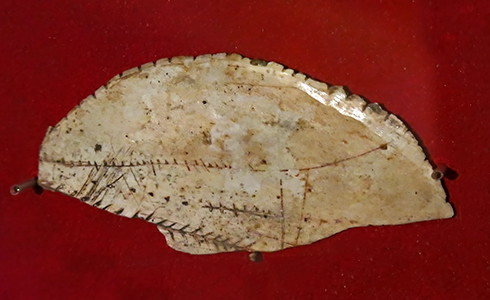
Rondelle with dentate and arrowhead decorations. The rim of the formerly circular rondelle has been decorated with notches.
Photo: Don Hitchcock 2015
Source: Original, La Salle Piette, Musée d'Archeologie Nationale et Domaine, St-Germain-en-Laye
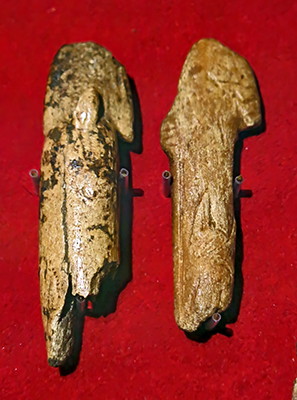
Two hooks for propulseurs, spear throwers.
(right) Magdalenian, from Grotte de Gourdan, of reindeer antler. Head of an animal face, perhaps a horse, with the an almond shaped eye, an ear with a middle incision, muzzle and mouth. Parallel lines, two dashed, are engraved on the left side.
The right side has two dotted lines and transverse and oblique cuts. The edge opposite the hook is engraved with transverse parallel streaks.
Length 58 mm, width 20 mm.
Catalog: 47191
Photo: Don Hitchcock 2015
Source: Original, La Salle Piette, Musée d'Archeologie Nationale et Domaine, St-Germain-en-Laye
Text: © Saint-Germain-en-Laye, musée des antiquités nationales, © Direction des musées de France, 2002
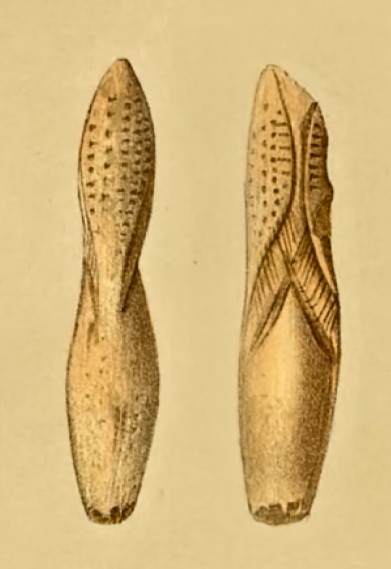

Indeterminate object, in ivory, from the Middle Magdalenian of Gourdan.
Engraved ellipses. Aligned notches.
( this object, which could be interpreted as a phallus entering a vulva, reminds me very strongly of the famous phallus from Mas d'Azil, see below - Don )
Piette (1907) writes: Mammoth ivory rod, with a cylindrical shape and a constriction that divides it into two olive shapes (seen from the side) united at their extremities, and adorned with pock marks and fringes, from Gourdan.
Length 58 mm, width 12 mm.
Catalog: 47040 - 47055 (47040 reassembled with 47055; There is doubt about the collector)
Photo (left) and additional text: Piette (1907)
Photo (right): Don Hitchcock 2015
Source: Original, La Salle Piette, Musée d'Archeologie Nationale et Domaine, St-Germain-en-Laye
Text: © Saint-Germain-en-Laye, musée des antiquités nationales, © Direction des musées de France, 2000

Phallus from Mas d'Azil.
Phallus
Carved ivory
Cat 359
Origin : Mas-d’Azil cave, Ariège
Photo: © Loïc Hamon, Musée des Antiquités nationales, Saint-Germain-en-Laye.
Source: http://www.culture.gouv.fr/culture/app/eng/96ce1735.htm
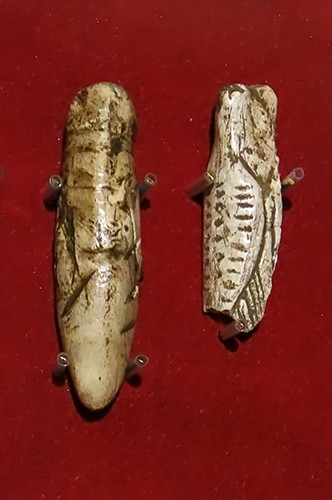
Two small carved and engraved pendants, with a swelling at the smaller end to allow for the attachment of a cord.
The pendant on the right is very similar in shape and carving to the phallus-like Catalog: 47040 - 47055 object, above the Mas-d'Azil phallus.
Photo and text: Don Hitchcock 2015
Source: Original, La Salle Piette, Musée d'Archeologie Nationale et Domaine, St-Germain-en-Laye
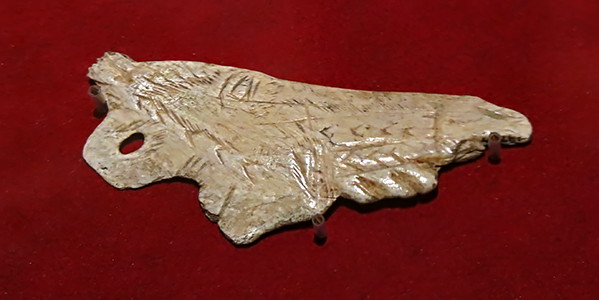
Découpé horse head, completed, as many were, using a horse hyoid bone, which is ideal for this shaped object.
It has a hole for suspension as a pendant, the eyes, muzzle and ears are indicated, and the whole is decorated with chevrons, with some shading lines.
Piette (1907) writes:
Bone engraved on both sides. Engraving with découpé outline. It represents a portion of equine head whose lower jaw has been detached. The skin of the upper jaw and nostrils appears to have been removed. The teeth are exposed. On the exposed flesh, the artist has made incisions representing lines of chevrons, as sometimes our butchers do on the animals they flay.
The artist therefore seems to have wanted to represent a prehistoric piece of butchery. However, engravers of other times have often covered portions of animals with chevrons or other geometrical lines, by pure fancy, without the animal having been skinned for it. The eye is small and simply engraved, without any relief. The forehead is slightly convex. The ear is located at the top and back, like those of Arudy. A hole made to suspend this object indicates that it served as a pendant. From Lortet.
Photo and additional text: Don Hitchcock 2015
Source: Original, La Salle Piette, Musée d'Archeologie Nationale et Domaine, St-Germain-en-Laye
Text: Piette (1907)
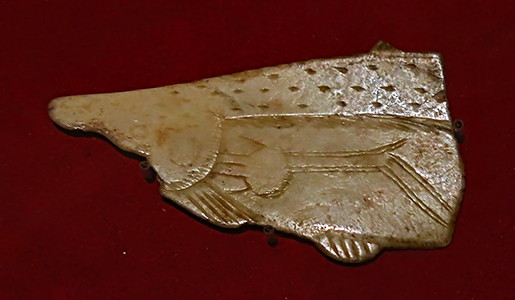
Découpé trout, on a scapula, from the Middle Magdalenian of Lortet, Layer II.
A beautifully carved and engraved trout, showing the head, eye, dorsal line, fins, and scales. Piette considered that the artist had also shown the digestive tract as a transparency.
Length 67 mm, width 37 mm, thickness 1 mm.
Photo: Don Hitchcock 2015
Source: Original, La Salle Piette, Musée d'Archeologie Nationale et Domaine, St-Germain-en-Laye
Text: © Saint-Germain-en-Laye, musée des antiquités nationales, © Direction des musées de France, 2002
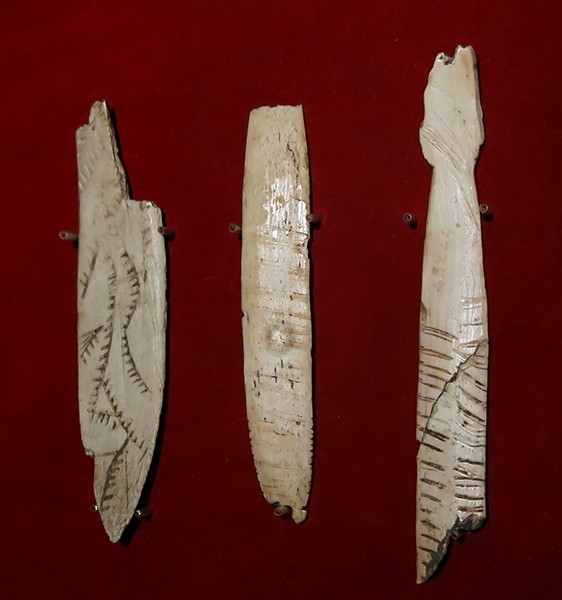
Three pendants.
(left) Described as a lissoir, used for working leather, this is from the Upper Magdalenian of Lortet, and is made from a rib. On the upper side, bearing sinuous lines sawtoothed and crossing each other, this is a beautifully crafted piece.
Length 89 mm, width 20 mm, thickness 2 mm.
Catalog: 48759
Photo: Don Hitchcock 2015
Source: Original, La Salle Piette, Musée d'Archeologie Nationale et Domaine, St-Germain-en-Laye
Text: © Saint-Germain-en-Laye, musée des antiquités nationales, © Direction des musées de France, 2004
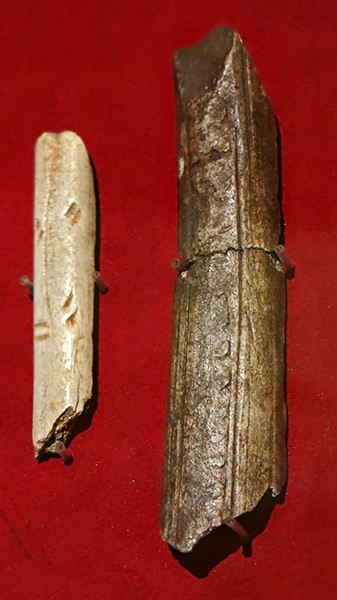
Two baguettes. The one on the right has a double bevel, indicating that it was used as a wedge (often called a 'ciseau') for splitting pre-grooved antler.
Both are decorated.
(left): Baguette demi-ronde, from the Magdalenian of Gourdan, Layer IV, in engraved bone.
The upper surface is decorated with a longitudinal groove, medial and irregular, on which are distributed on each side, two groups of oblique double cuts. On the underside, there are three parallel oblique lines.
Length 60 mm, width 12 mm.
Catalog: 51305
Photo: Don Hitchcock 2015
Source: Original, La Salle Piette, Musée d'Archeologie Nationale et Domaine, St-Germain-en-Laye
Additional text: © Saint-Germain-en-Laye, musée des antiquités nationales, © Direction des musées de France, 2004
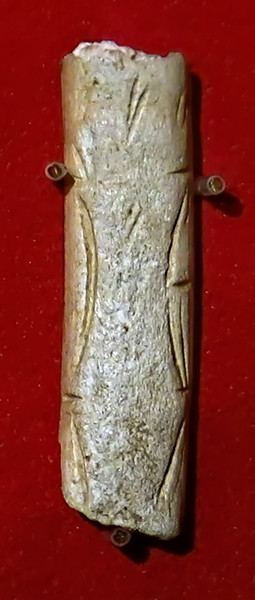
Baguette demi-ronde in engraved bone from the Upper Magdalenian of Lortet.
Two lateral rows of long crescents separated or marked by transverse cuts. Four groups of oblique double streaks at one end. The flat face (underside) has oblique parallel striations.
( Baguettes demi-rondes were created and used in pairs to hold the point of the spear or dart. The flat face, against the flint point, was often scored with oblique striations in order to help adhesion of the birch bark glue used to attach the point on the end of the projectile, in combination with sinew bound around the whole, often with further birch bark glue, for strength - Don )
Length 42 mm, width 11 mm, thickness 5 mm.
Catalog: 48763
Photo: Don Hitchcock 2015
Source: Original, La Salle Piette, Musée d'Archeologie Nationale et Domaine, St-Germain-en-Laye
Text: © Saint-Germain-en-Laye, musée des antiquités nationales, © Direction des musées de France, 2004
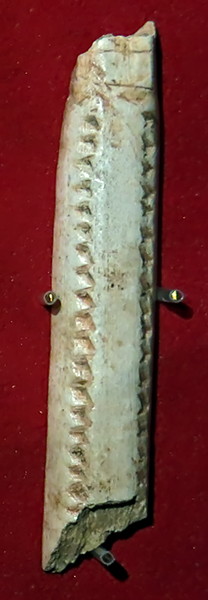
Baguette demi-ronde in engraved reindeer antler from the Middle Magdalenian of Lortet.
On the upper side, two parallel lines of small notches in a sawtooth pattern. At one end, two parallel transverse striations. On the flat underside, aligned oblique streaks.
Length 65 mm, width 12 mm, thickness 6 mm.
Catalog: 48222
Photo: Don Hitchcock 2015
Source: Original, La Salle Piette, Musée d'Archeologie Nationale et Domaine, St-Germain-en-Laye
Text: © Saint-Germain-en-Laye, musée des antiquités nationales, © Direction des musées de France, 2003
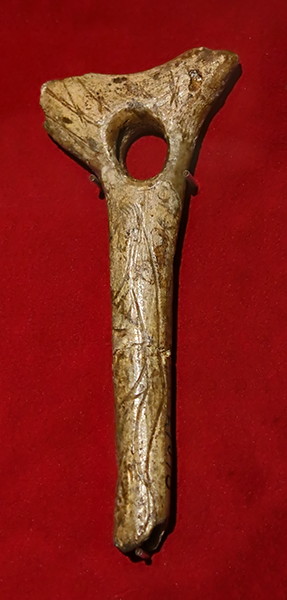
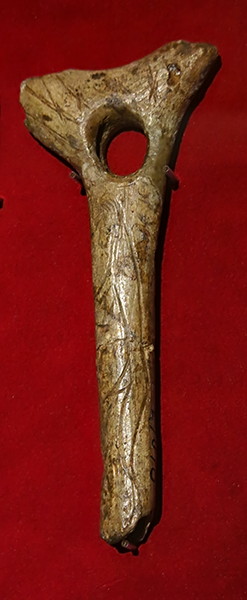

Pierced baton from Gourdan, with a man standing in profile, showing an erect penis.
( This drawing of the engraving on the pierced baton from Piette (1907) shows that the head of the man has distinctly canine or equine features. It may be a representation of a shaman - Don )
Photo (left): Don Hitchcock 2015
Source: Original, La Salle Piette, Musée d'Archeologie Nationale et Domaine, St-Germain-en-Laye
Photo (right) and text: Piette (1907)
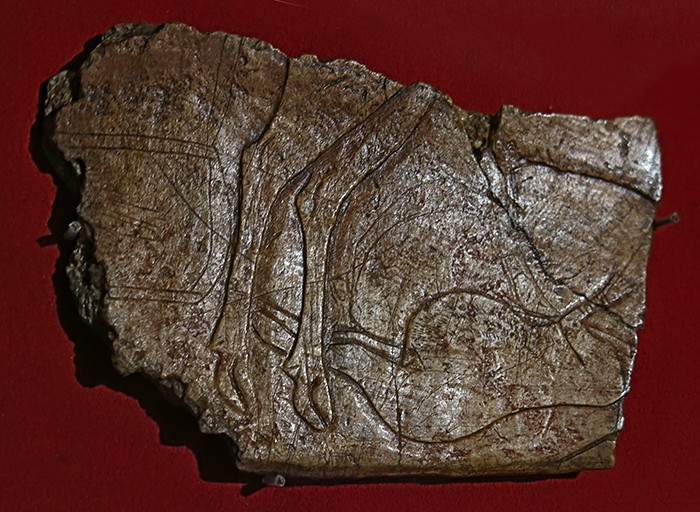
La Femme au renne
Sculpture in very low relief on the 'palm' of a reindeer antler, from the Upper Magdalenian. The woman is in a horizontal position, lying behind the reindeer, some distance away. She is naked, wearing bracelets and wearing a necklace. The head is missing. The belly is huge, the woman seems pregnant. There are many villi on the thighs and on the belly. those of the belly form vertical bands.
M. G. de Mortillet, who had represented this woman in the upright position, without having seen the original, has persisted in keeping it there, assuming that she does not form a group with the reindeer.
But the features of the woman's legs do not cut those of the reindeer, because she is placed behind him and further away. The two figures were carved at the same time and form a tableau. Laugerie Bass.
Photo: Don Hitchcock 2015
Source: Original, La Salle Piette, Musée d'Archeologie Nationale et Domaine, St-Germain-en-Laye
Catalog: 47001
Text: Piette (1907)
Additional text: © Saint-Germain-en-Laye, musée des antiquités nationales, © Direction des musées de France, 2002
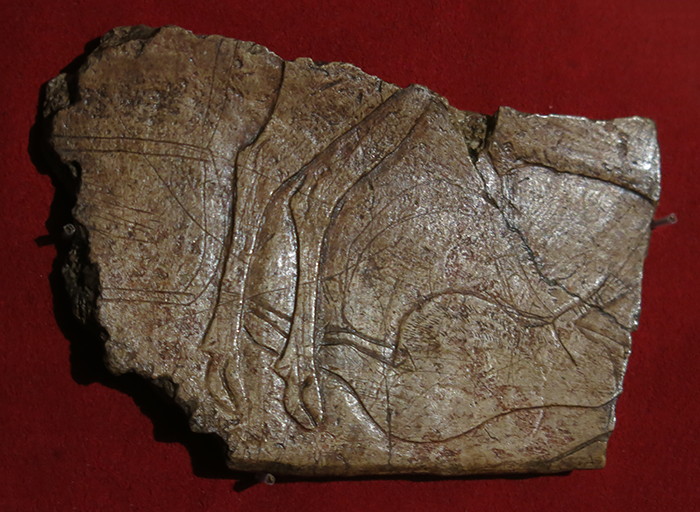
La Femme au renne
Reindeer engraved in right profile on the palm of a reindeer antler, in differential relief, of which only the lower part remains, with the ventral line and the hind legs. Between the legs of the reindeer, is a naked woman, lying on her back, probably pregnant, wearing necklace and bracelets. The head and the left arm were fractured. Presence of a quadrangular pattern. On the other side, a horse has been engraved in left profile but there remains only the front end of the animal.
The reindeer is carved in very low relief, using champlevé as much as sculpture. The woman is engraved only in champlevé. The artist, by varying the process, undoubtedly wanted to express the distance of the woman from the viewer.
Length: 101 mm, width 65 mm.
Photo: Don Hitchcock 2015
Source: Original, La Salle Piette, Musée d'Archeologie Nationale et Domaine, St-Germain-en-Laye
Catalog: 47001
Text: Piette (1907)
Additional text: © Saint-Germain-en-Laye, musée des antiquités nationales, © Direction des musées de France, 2001
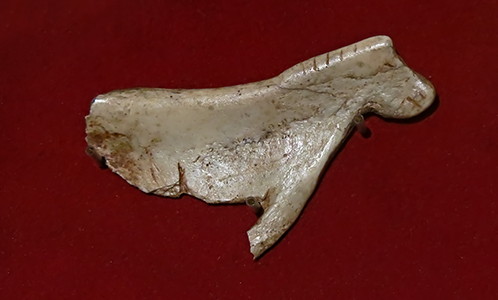
Découpé pendant (?) of a horse, found by Piette in the cave of Lorthét (Lortet). Middle Magdalenian.
Engraving in a scapula, with cut out contours, representing an equine. Simple lines engraved indicate the mouth, nose, eyes, mane and ear. This ear, straight and short, is directed forward. The beard, very badly made, makes the head seem too thick, although overall the head is too short.
58 mm x 28 mm x 35 mm
Catalog: 47309
Photo: Don Hitchcock 2015
Source: Original, La Salle Piette, Musée d'Archeologie Nationale et Domaine, St-Germain-en-Laye
Text: Piette (1907)
Additional text: © Saint-Germain-en-Laye, musée des antiquités nationales, © Direction des musées de France, 2002
Pierced baton of reindeer antler from the Magdelanian, engraved with the representation of a goose and a horse.
The goose has been completed in the champlevé style, where the outline is deeply and widely incised, to create the impression of relief.
Length 340 mm, width 35 mm, with three perforations.
Photo: Don Hitchcock 2015
Source: Original, La Salle Piette, Musée d'Archeologie Nationale et Domaine, St-Germain-en-Laye
Text: Piette (1907)
Additional text: © Saint-Germain-en-Laye, musée des antiquités nationales, © Direction des musées de France, 2002
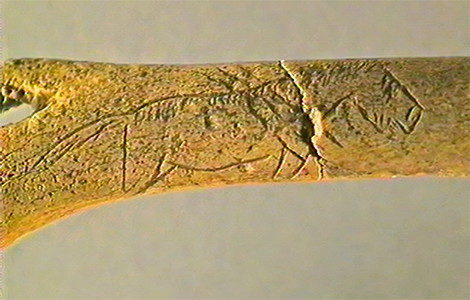
On the other side of the pierced baton to the goose, not visible in my photo, is this less finished engraving of a horse.
Photo: © Saint-Germain-en-Laye, musée des antiquités nationales, © Direction des musées de France, 2002
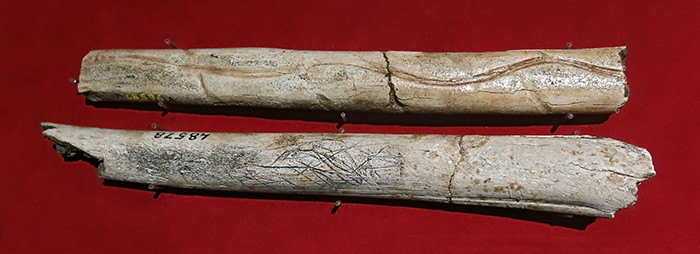
Two batons.
(upper) Reindeer antler baton, Gourdan, from the upper Magdalenian, layer IV-V.
Oblique, deep incision. On one side, a wide sinuous line confined on either side by deep irregular oblique cuts. On the other side, a ( faint ) stylisation of a bison head seen from the front, with the horns, ears, and forelock shown.
Length 203 mm, width 24 mm.
Catalog: 48596
(lower) Reindeer antler baton, Gourdan, from the Magdalenian.
On the lateral edges, two deep longitudinal grooves are visible, the antler split at these points. The left lateral edge bears two large ellipses with pointed ends, deeply engraved, and many features are superimposed. On the other side, four large chevrons follow each other and seem to be distributed along a split of the antler. The chevrons are crossed by a multitude of randomly organised lines. This group of lines is concentrated in the centre of the piece.
Length 221 mm, width 27 mm, thickness 23 mm.
Catalog: 48578
Photo: Don Hitchcock 2015
Source: Original, La Salle Piette, Musée d'Archeologie Nationale et Domaine, St-Germain-en-Laye
Text: © Saint-Germain-en-Laye, musée des antiquités nationales, © Direction des musées de France, 2002
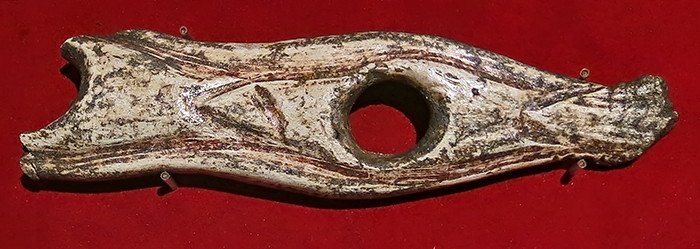
Pierced baton of reindeer antler from the upper Magdalenian, with two perforations, from Gourdan. Engraved in light relief, with a representation of a fish, as well as a geometric, abstract decoration around the holes.
Length 110 mm, width 13 mm.
Catalog: 47051
Photo: Don Hitchcock 2015
Source: Original, La Salle Piette, Musée d'Archeologie Nationale et Domaine, St-Germain-en-Laye
Text: © Saint-Germain-en-Laye, musée des antiquités nationales, © Direction des musées de France, 2002

Magdalenian plaquette from the abri Laugerie-basse, Les Eyzies-de-Tayac-Sireuil, discovered by Landesque.
Fragment of mammoth ivory, coloured with ochre, polished, with geometric ornament.
It is covered with imaginative designs, consisting of circles or polyhedra, arranged in curved lines and gradually diminishing in size, in triangles or chevrons, in parallel stripes, and a row of U shaped signs.
Traces of ochre in the bottom of some incisions. Geometric decoration on one side: two rows of champlevé circles are surrounded by sinuous lines. On the sides are, on the one side oblique lines, on the other side polygonal patterns aligned forming a kind of maze.
Length 81 mm, width 21 mm, thickness 5 mm.
Catalog: 47446
Photo: Don Hitchcock 2015
Source: Original, La Salle Piette, Musée d'Archeologie Nationale et Domaine, St-Germain-en-Laye
Text: © Saint-Germain-en-Laye, musée des antiquités nationales, © Direction des musées de France, 2002
Additional text: Piette (1907)
Scapula from the upper Magdalenian of Gourdan.
Medium width incisions. Beautiful ibex head engraved, left profile, showing the curved horn, two erect ears, a big oval outlined eye, hairs of the coat shown on the cheek and on the neck line.
Length 83 mm, width 34 mm, thickness 28 mm.
Catalog: 48572
Photo (left): Don Hitchcock 2015
Source: Original, La Salle Piette, Musée d'Archeologie Nationale et Domaine, St-Germain-en-Laye
Photo (right) and text: © Saint-Germain-en-Laye, musée des antiquités nationales, © Direction des musées de France, 2003

Engraved bone, from the Upper Magdalenian of Gourdan.
On one side: a singular decoration composed of seven transverse and aligned lines, each end of which bears oblique divergent lines. On both sides are broken and sinuous lines.
Length 67 mm, width 12 mm, thickness 11 mm.
Catalog: 47434
Photo: Don Hitchcock 2015
Source: Original, La Salle Piette, Musée d'Archeologie Nationale et Domaine, St-Germain-en-Laye
Text: © Saint-Germain-en-Laye, musée des antiquités nationales, © Direction des musées de France, 2003
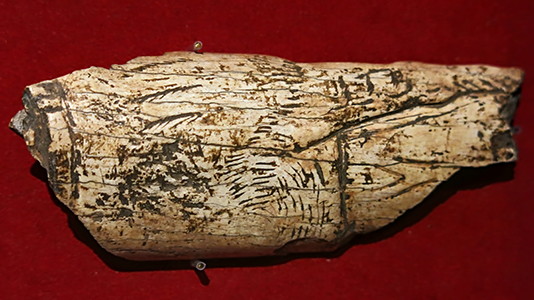
Engraved bone.
This bone has been engraved with an image made up of short lines in a pointillist style, possibly of a large waterbird with a long neck.
To the left of this image are two prominent and thick engraved lines, with oblique narrow lines crossing them, rather like a representation of feathers. The engravings stand out in black, as though the piece has been coated with manganese dioxide, and polished, leaving the manganese dioxide in the grooves of the engraving.
Photo and text: Don Hitchcock 2015
Source: Original, La Salle Piette, Musée d'Archeologie Nationale et Domaine, St-Germain-en-Laye
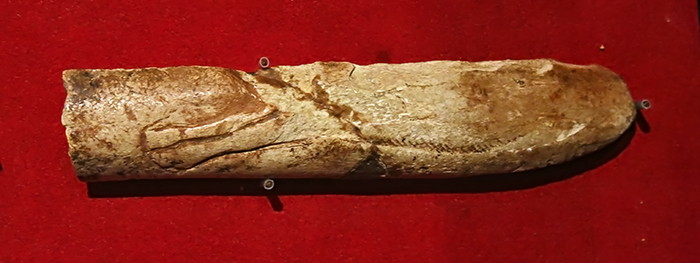
Engraved and carved reindeer antler, from the Middle Magdalenian of le Mas-d'Azil, Layer IV, right bank, used as a wedge (ciseau) for splitting antler prepared by grooving with a burin.
( The carving, done in champlevé style, shows the two front legs, the lower chest, and the abdomen of an animal which is probably an ungulate, in the act of running or fleeing, with the legs almost horizontal in front of the animal.
The fur of the animal is shown in hatching along the line of the abdomen. It is probable that the depiction of the animal continues (or originally continued) on the other side of the piece.
- Don )
Fractured forequarters of an animal with a left profile, running. The forelegs are done in champlevé, stretched forward, with the details of the hoof, the ergot, and the ventral line made of short streaks aligned and parallel.
Length 92 mm, width 19 mm, thickness 11 mm.
Catalog: 47212
Photo and text: Don Hitchcock 2015
Source: Original, La Salle Piette, Musée d'Archeologie Nationale et Domaine, St-Germain-en-Laye
Additional Text: © Saint-Germain-en-Laye, musée des antiquités nationales, © Direction des musées de France, 2002
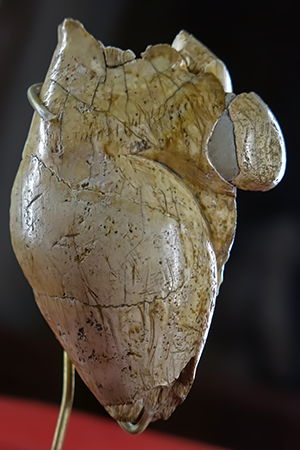
La Poire
27 000 BP
La Poire is a figurine of mammoth ivory of which only the corpulent torso survives, found in 1892 in the 'Grotte du Pape' at Brassempouy in the Department of Les Landes and now in the Musée St. Germain-en-Laye. The name 'Venus' for this figurine was subsequently adopted by Édouard Piette (1827-1906).
She was originally nicknamed la poire - 'the pear' - on account of her shape. For Piette, the name 'Venus' may have come to mind in this particular instance because of the emphatic treatment of the vulva's labia and the prominent, slightly protruding pubic area, which he tastefully refers to as 'le mont de Vénus' - the mound of Venus (or mons pubis). 'Venus' has since become the collective term used to identify all obese Palaeolithic statuettes of women.
Text above adapted from http://arthistoryresources.net/willendorf/willendorfname.html
Dimensions: 43 mm x 25 mm x 26 mm.
Photo: Don Hitchcock 2015
Source: Original, La Salle Piette, Musée d'Archeologie Nationale et Domaine, St-Germain-en-Laye
Text: http://www.photo.rmn.fr/cf/
Additional text: adapted from http://arthistoryresources.net/willendorf/willendorfname.html


The figurine fragment known as l'Ébauche, (the rough-out) was found during the AFAS excursion of September 19, 1892.
Piette says: This is the lower part of an unfinished male statuette. We can still see the marks of the burin. The feet are unfinished. The legs and thighs are those of a man and have nothing reminiscent of a woman's hips. This is probably the bottom of a pendant.
Photo: Don Hitchcock 2015
Source: Original, La Salle Piette, Musée d'Archeologie Nationale et Domaine, St-Germain-en-Laye
Text: Piette (1907)
Engraved plaquette of green sandstone from the Magdalenian of Lortet.
( note that the description below is far more detailed than I can make out on the photo of the original. - Don )
The decoration covering this plate consists of a right profile bison and many indeterminate features. Near the left edge, we distinguish the remains of the bison's mane. It is represented in vertical or oblique lines.
The area of the horn and ear is destroyed, the eye is circular and incomplete; two horizontal lines frame it. The eyebrow is rendered by a rectilinear line above the eye, and the snout is square. The nose is semicircular, closed in its lower part by a horizontal dash. The mouth is half-open, and we can distinguish the incisors and perhaps the tongue.
The back of the jaw is rectilinear and we distinguish the beginning of the mandibular arch. A vigorous line draws the limits of a triangular beard, with a filling of parallel oblique lines. We can distinguish the start of the cannon with a rather confused filling of long parallel lines, intersected with short incisions, poorly preserved. In the lower left, the surface is scraped and we can discern an eye. In the lower right, a section of horn with growth rings may be shown.
Length 94 mm, width 80 mm, thickness 7 mm.
Catalog: 48140
Photo (left): Don Hitchcock 2015
Source: Original, La Salle Piette, Musée d'Archeologie Nationale et Domaine, St-Germain-en-Laye
Photo (right) and text: © Saint-Germain-en-Laye, musée des antiquités nationales, © Direction des musées de France, 2002
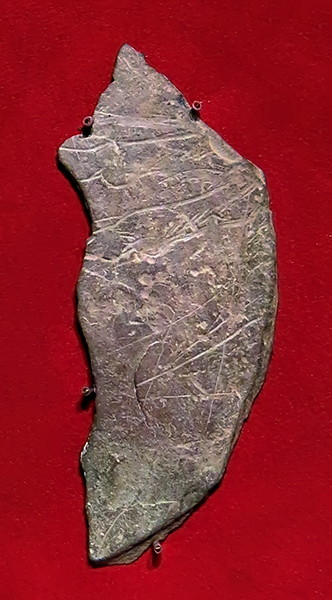
Schist engraved with the legs of an animal, possibly a horse, Upper Magdalenian, from layers IV-V of Lortet.
Two legs of an animal in left profile, showing the ergot ( a small callosity on the underside of the fetlock - Don ) and hoof. Near this figure, some other oblique lines.
Length 92 mm, width 35 mm, thickness 3 mm.
Catalog: 48268
Photo: Don Hitchcock 2015
Source: Original, La Salle Piette, Musée d'Archeologie Nationale et Domaine, St-Germain-en-Laye
Text: © Saint-Germain-en-Laye, musée des antiquités nationales, © Direction des musées de France, 2003

Schist plaquette engraved with a glutton (wolverine), from the Upper Magdalenian of Lortet.
Wolverine forequarters engraved in right profile. Superimposed, further down, a reindeer head engraved in right profile.
Length: 73 mm, width 72 mm, thickness 6 mm.
Catalog: 47267
Photo: Don Hitchcock 2015
Source: Original, La Salle Piette, Musée d'Archeologie Nationale et Domaine, St-Germain-en-Laye
Text: © Saint-Germain-en-Laye, musée des antiquités nationales, © Direction des musées de France, 2002
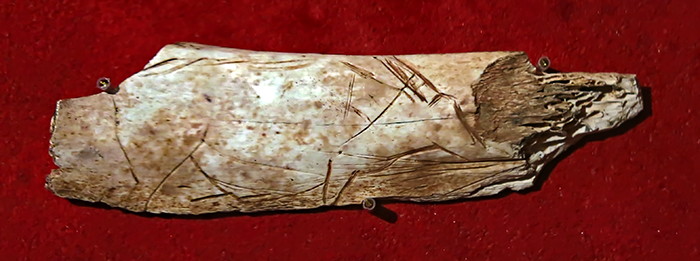
Engraved rib, from the Middle Magdalenian, layer IV of le Mas-d'Azil.
An engraving of an ibex: standing, right profile, head, annular ringed horn, triangular eye, with a snout, neck, chest, legs, and rump.
Length 77 mm, width 22 mm, thickness 7 mm.
Catalog: 47195
Photo: Don Hitchcock 2015
Source: Original, La Salle Piette, Musée d'Archeologie Nationale et Domaine, St-Germain-en-Laye
Text: © Saint-Germain-en-Laye, musée des antiquités nationales, © Direction des musées de France, 2003
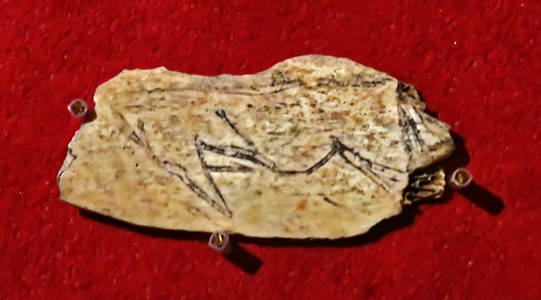
Decorated rib from the Upper Magdalenian, on the right bank of Layer V, of le Mas-d'Azil.
Bison partially carved and engraved in right profile. The right end is broken. We can make out the cervicodorsal line, the chest, the ventral line, the two legs, the rump, and the tail. The flank bears an oblique line. On the other side there are grooves.
Length 33 mm, width 16 mm, thickness 3 mm.
Catalog: 47981
Photo: Don Hitchcock 2015
Source: Original, La Salle Piette, Musée d'Archeologie Nationale et Domaine, St-Germain-en-Laye
Text: © Saint-Germain-en-Laye, musée des antiquités nationales, © Direction des musées de France, 2002
Additional text: Piette (1907)



Propulseur, spear thrower, in reindeer antler from the Magdalenian of le Mas-d'Azil.
This atlatl is exceptionally complete. Its proximal part allowing a fitting to another shaft ends in a double bevel, which is not frequent for this type of object. The shaft is decorated with a frontal view of an ibex treated in relief and integrating perfectly with the shape of the piece.
The head is particularly well detailed with round eyes and nostrils well marked. Under the chin, an engraved element could be the goatee beard. The annular ringed horns wrap around the barrel and meet on the opposite side. The body is stocky, provided with large legs, whose cloven hoofs are shown.
Length 265 mm, width 21 mm, thickness 18 mm.
Catalog: 47025
Photo: Don Hitchcock 2015
Source: Original, La Salle Piette, Musée d'Archeologie Nationale et Domaine, St-Germain-en-Laye
Text: © Saint-Germain-en-Laye, musée des antiquités nationales, © Direction des musées de France, 2000
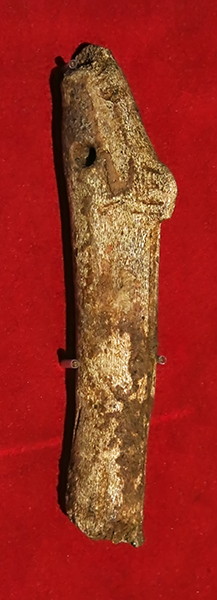
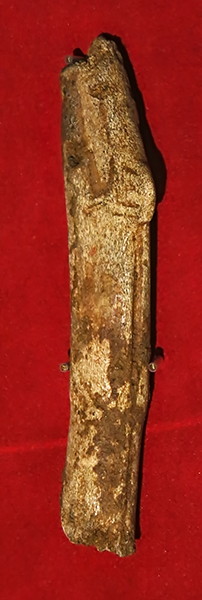
Propulseur, spear thrower, in reindeer antler from the Middle Magdalenian of Gourdan.
The piece represents a fish. It shows the head, hollows for the eyes and orbits, and a fin.
Length 94 mm, width 24 mm.
Catalog: 47045
Photo: Don Hitchcock 2015
Source: Original, La Salle Piette, Musée d'Archeologie Nationale et Domaine, St-Germain-en-Laye
Text: © Saint-Germain-en-Laye, musée des antiquités nationales, © Direction des musées de France, 2000
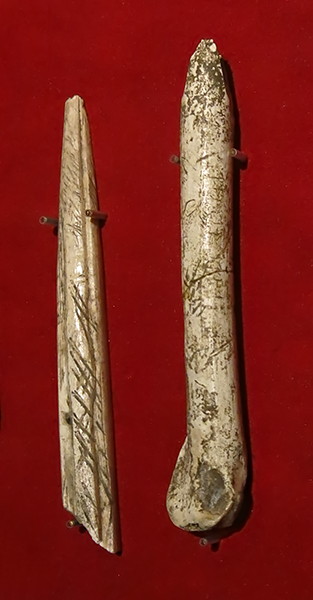
(left) Bone or reindeer antler object, narrowing to a point, with a raised midrib, scored by a latticework of lines. Flat on the undersurface, it is possibly a pendant.
(right) Probably reindeer antler, double beveled wedge (ciseau), with a set of parallel transverse lines down the shaft, possibly with other engraving as well. The other end seems to be in a shallow spoon shape for an unknown purpose.
Photo and text: Don Hitchcock 2015
Source: Original, La Salle Piette, Musée d'Archeologie Nationale et Domaine, St-Germain-en-Laye
Engraved thick bone, Middle Magdalenian, from the left bank of Le Mas-d'Azil.
The forequarters of a horse, left profile, with head, erect mane, eye, forehead, back of the jaw, front leg.
Superimposed, an animal - engraved in left profile, that has been described as a seal. Three other 'seals' have been engraved, one below the first, the other two arranged symmetrically, of right profile, in the opposite direction of the first 'seal'. These four animals have bodies which are marked with parallel streaks, a head, a large, round eye, and perhaps an anterior limb.
Length 138 mm, width 46 mm, thickness 16 mm.
Catalog: 48118
Photo (below): Don Hitchcock 2015
Source: Original, La Salle Piette, Musée d'Archeologie Nationale et Domaine, St-Germain-en-Laye
Photos (above) and text: © Saint-Germain-en-Laye, musée des antiquités nationales, © Direction des musées de France, 2003

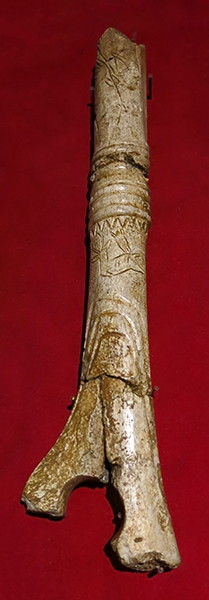
Pierced baton from the upper Magdalenian of Gourdan.
Pierced baton fragment covered with very interesting engravings. They are the work of two engravers who have affixed their signatures. So there were well-known engravers who were proud of their works. People who wanted to have ceremonial, high quality pieces used them for this work.
The two signed engravings are one on one side of the rod, the other on the other side, in different frames.
One represents pike, engraved with a great lightness of touch; the engraver's signature consists of two groups of dimples that make one think of the crowns of a count. The other represents the anterior part of the body of an aurochs seen from the back. This is drawn by an artist who sought difficulty; the signature consisted of two curved lines intersecting with two straight lines. This figure was repeated twice. I have reproduced, in plate XXXIX, fig. 1, an engraving from Lorthét (Lortet), representing a file of reindeer, signed by its author with two diamonds.
It will be remarked that, in this plate, as in that of Lorthét (Lortet), each signature consists of a figure repeated twice. It would be wrong to claim that these figures are marks of ownership. If that were so, the brand would be the same for the aurochs and the pike. They are different. Besides, the signatures are placed in the middle of the engravings. A property mark would be in a more obvious place.
On the lower part of the shaft, is another engraving representing an antelope of fantasy, near which are two inscriptions consisting, on one side, of two groups of four lines and two signs similar to an X, and on the other side, two groups of six lines.
Photo (right): Don Hitchcock 2015
Source: Original, La Salle Piette, Musée d'Archeologie Nationale et Domaine, St-Germain-en-Laye
Photo (left) and text: Piette (1907)
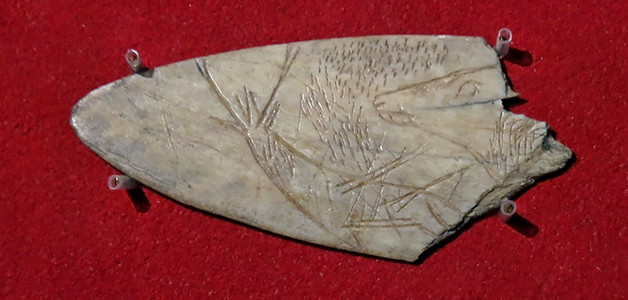
The end of a bone spatula ( or lissoir ) on which are engraved a head that appears to be that of a wolf and a fantastic animal with four horns that may be a mark of ownership ( or that of the artist - Don ). We find this symbolic being on other engraved bones.
From Layer V on the left bank of the river Arise which flows through Mas-d'Azil.
On one side is a deer whose head is seen from the back, with branched antlers and ears, and whose body is turned to the left. On his right, an indeterminate animal's head, seen in left profile and surrounded by a group of fine striations.
Dimensions: 55 x 26 x 2 mm.
Catalog: 47283
Photo: Don Hitchcock 2015
Source: Original, La Salle Piette, Musée d'Archeologie Nationale et Domaine, St-Germain-en-Laye
Text: Piette (1907)
Additional text: © Saint-Germain-en-Laye, musée des antiquités nationales, © Direction des musées de France, 2002

( Since this owner's/artist's mark is very similar to a strange deer-like 'antelope of fantasy' animal also seen from the back in the pierced baton seen above, it is possibly from the same artisan, and thus also from the upper Magdalenian of Gourdan - Don )
Photo: Piette (1907)
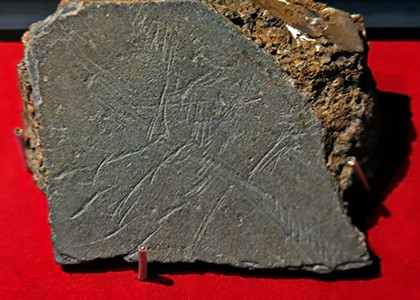
On this engraved schist plaquette, there are two front legs that could be attributed to a right profile bison. The knee, the ergot and the hoof may be discerned. The hair of the belly and perhaps the chest are also visible. A few lines cross the figure.
Layers IV-V of Lortet, Upper Magdalenian.
Dimensions: Length 76 mm, Width 56 mm, thickness 5 mm.
Catalog: 48259
Photo: Don Hitchcock 2015
Source: Original, La Salle Piette, Musée d'Archeologie Nationale et Domaine, St-Germain-en-Laye
Text: © Saint-Germain-en-Laye, musée des Antiquités nationales, © Direction des musées de France, 2003
Spatula or lissoir engraved with a fish on the right, and three groups of three parallel lines on the left.
Photo: Don Hitchcock 2015
Source: Original, La Salle Piette, Musée d'Archeologie Nationale et Domaine, St-Germain-en-Laye
Spatula or lissoir engraved with a two sub-parallel lines filled with cross hatching on the left, and modifications of this idea to form a y and a v shape on the right.
Both edges are decorated with very worn down notches, which means that the object was probably also used as a musical instrument, an ideophone or scraper, by rubbing a stick against it. This instrument is often associated with magical powers and ritual, and is widely distributed geographically.
The engraved designs may well have had spiritual or magical significance.
Further evidence of its use as an ideophone is that the notches are only on the middle and right of the object, leaving room for the hand to grasp the bone on the left while playing the instrument.
Photo: Don Hitchcock 2015
Source: Original, La Salle Piette, Musée d'Archeologie Nationale et Domaine, St-Germain-en-Laye

This is a very curious object. Apparently made from a rib, it is decorated with a series of straight and curved parallel lines on each side, which is not at all rare, but rather common.
However what is most unusual is the sinuous double (or more) curves engraved down the longitudinal centre. It is tempting to see it as a representation of a river, or as a series of mountains, a map.
Photo: Don Hitchcock 2015
Source: Original, La Salle Piette, Musée d'Archeologie Nationale et Domaine, St-Germain-en-Laye
An abstract design on part of a lissoir, made from a rib bone, used for working hides into leather.
From Lortet, in the High Pyrenees, the Upper Magdalenian.
On the right, a row of partially ruptured nested chevrons, and two interlocking chevrons on a midline.
Dimensions: Length 85 mm, width 15 mm, thickness 2 mm.
Catalog: 47414
Photo: Don Hitchcock 2015
Source: Original, La Salle Piette, Musée d'Archeologie Nationale et Domaine, St-Germain-en-Laye
Text: © Saint-Germain-en-Laye, musée des antiquités nationales, © Direction des musées de France, 2002
Horse head engraved on what may be a rib, from the Middle Magdalanian of Lortet, Hautes-Pyrénées.
Horse head engraved in left profile: forelock, ear, almond shaped eye with pupil, shortened snout, nose, mouth, underlined cheek, chin, lower jaw, beard.
Dimensions: Length 87 mm, width 22 mm, thickness 8 mm.
Catalog: 48203
Photo: Don Hitchcock 2015
Source: Original, La Salle Piette, Musée d'Archeologie Nationale et Domaine, St-Germain-en-Laye
Text: © Saint-Germain-en-Laye, musée des antiquités nationales, © Direction des musées de France, 2003
Bone on which are engraved various animals or simplified images, including a reindeer. The artist, who was probably not happy with his work, covered them with a row of chevrons (fig 4). Fig 4a shows these animals without the chevrons.
Photo (above): Don Hitchcock 2015
Photo (below) and text: Piette (1907)
Source: Original, La Salle Piette, Musée d'Archeologie Nationale et Domaine, St-Germain-en-Laye
This object is from the Lorthét (Lortet) cave.
The engraving represents a parade of reindeer on an almost cylindrical antler trimmed at one of its ends. A female who is behind and bears a beautiful antler turns around to call her fawn. Salmon were engraved between the legs of the reindeer. The artist has put their signature to this work, consisting of two diamonds in the centre of each of which is a small vertical line.
Photo: Don Hitchcock 2015
Source: Original, La Salle Piette, Musée d'Archeologie Nationale et Domaine, St-Germain-en-Laye
Text: Piette (1907)
The stick of Lortet unrolled.
Photo: ©RMN, Thierry Le Mage.nal, La Salle Piette, Musée d'Archeologie Nationale et Domaine, St-Germain-en-Laye
Text:http://www.musee-aurignacien.com/fr/une-semaine-une-oeuvre-aurignacienne-ndeg6
The artists of these times possessed a marvellous faculty for representing an engraved object of which they saw only a part, either because it was drawn on a revolving surface of which only one side was in the field of their sight, or because it was incompletely drawn. It is this facility that made it easy for them to create many symbols.
Photo and text: Piette (1907)

Engraving of a deer, Upper Magdalenian, Gourdan, on a bone from a bird.
The outline of a deer, left profile, has been cut in an asymmetric v. Most of the head is broken off. The ear is present, as well as the cervico-dorsal line, the short tail, the hindquarters, the hind legs, the ventral line, the forelegs, and the chest. The body is underlined by a filling of parallel lines. Above the animal are two adjoining chevrons. A double chevron points to the back of the animal.
Length 66 mm, width 16 mm, thickness 11 mm.
Catalog: 48145
Photo: Don Hitchcock 2015
Source: Original, La Salle Piette, Musée d'Archeologie Nationale et Domaine, St-Germain-en-Laye
Text: © Saint-Germain-en-Laye, musée des antiquités nationales, © Direction des musées de France, 2003
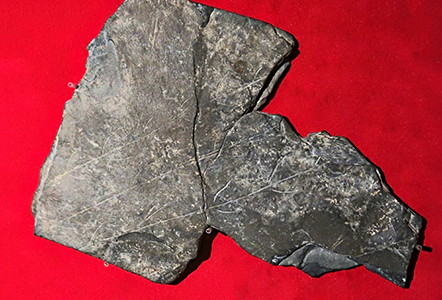
Engravings on a schist plaquette, from the Upper Magdalenian of Gourdan. The engravings are quite numerous and very legible. In the centre of the piece are three oblique continuous or discontinuous lines. On each of them are joined, at regular intervals, chevrons drawn in continuous or discontinuous lines. In the right part of the plaquette, we can infer the rest of a similar set. Piette saw it as a representation of a tree or a plant.
Length 130 mm, width 115 mm, thickness 5 mm.
Catalog: 47185
Photo: Don Hitchcock 2015
Source: Original, La Salle Piette, Musée d'Archeologie Nationale et Domaine, St-Germain-en-Laye
Text: © Saint-Germain-en-Laye, musée des antiquités nationales, © Direction des musées de France, 2003
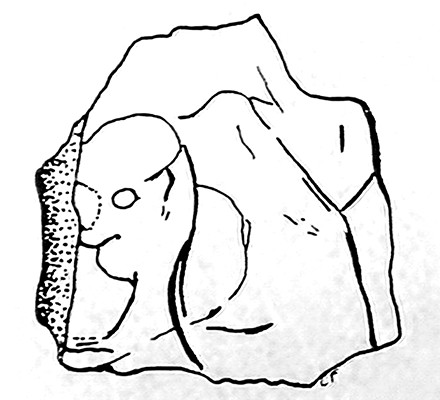
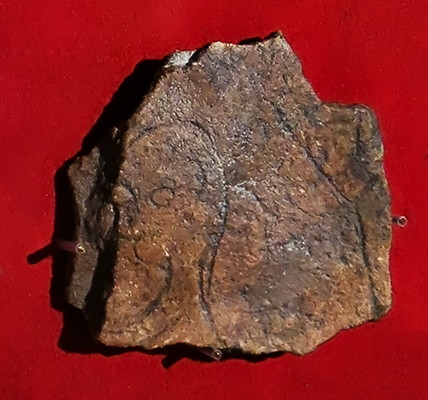
Engraved calcite plaquette from Gourdan layer IV-V, Upper Magdalenian.
A human head, left profile. The head is oval, supported by a thin neck, well clear of the shoulders; no trace of hairiness, the nose-nasal profile is destroyed, but the remaining nostril and end of the nose show that the nose was large. On the other hand, the chin is small, pressed against the throat; there is no mouth; the remaining eye is oval, and well proportioned. The ear is a simple vertical curve. A line starts from the back of the skull, passes over the ear, but stops before the eye. The engraving is completed in symmetrical and asymmetrical v shaped incisions of medium depth.
Length 48 mm, width 46 mm, thickness 6 mm.
Catalog: 48549
Photo (left): © Saint-Germain-en-Laye, musée des antiquités nationales, © Direction des musées de France, 2003
Photo (right): Don Hitchcock 2015
Source: Original, La Salle Piette, Musée d'Archeologie Nationale et Domaine, St-Germain-en-Laye
Text: © Saint-Germain-en-Laye, musée des antiquités nationales, © Direction des musées de France, 2003
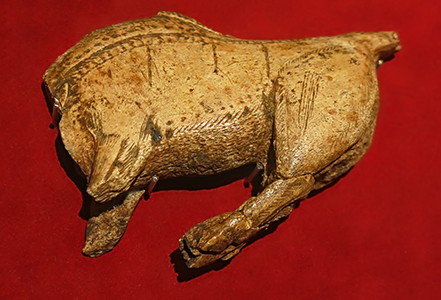
Propulseur from the Magdalenian of la grotte du Mas-d'Azil, in reindeer antler, using the champlevé technique.
With fine v shaped engraving furrows, the piece is a sculpture in the round. The bison is carved entirely from the palm of a reindeer antler, whose thickness indicates that is from a male. An old fracture took away the head.
Breakages during the excavation broke the legs and suggest that the animal was connected to a longer support, the long piece of reindeer antler then forming the shaft of the spear thrower as with other objects from Mas-d'Azil. However, the hypothesis of a pierced baton cannot be ruled out.
The sculptural carving has isolated the four legs and created an empty space under the abdomen, revealing the spongy tissue of the central part of the reindeer antler. This unusual feature is reminiscent of another propulseur from Mas-d'Azil, the 'Fawn with birds'.
The animal seems to be stationary, head down, limbs set and tail erect. Its light form and the absence of a penile shaft means that this is a female. This reading is confirmed by the presence of a vulva in slight relief. Under the broken tail, we can see the anal orifice. The volumes and essential details reflect a perfect knowledge of the living model and optimal exploitation of the raw material.
Length 110 mm, width 80 mm, thickness 28 mm.
Catalog: 47037
Photo: Don Hitchcock 2015
Source: Original, La Salle Piette, Musée d'Archeologie Nationale et Domaine, St-Germain-en-Laye
Text: © Saint-Germain-en-Laye, musée des antiquités nationales, © Direction des musées de France, 2000
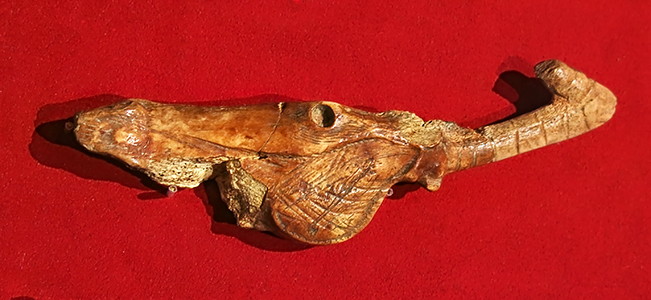
Propulseur from the Middle Magdalenian of la grotte du Mas-d'Azil, in reindeer antler, coloured with red ochre.
Fine medium asymmetrical 'v' incision, deeply cut, with red ochre staining. The carved and engraved horse's head, in the style known as 'flayed', shows excavated eyes, a prominent cheek, muzzle, and mouth, and well drawn nostril. Every contour is accentuated by fine, oblique streaks. The ears have been broken off.
The surface of the hook is entirely covered with regular transverse or oblique streaks. The proximal portion of the propulseur is fractured and appears to have been altered by percussion at the level of the horse's muzzle. If this were the case, the spear thrower would have been reused as an intermediate piece in another propulseur.
Length 89 mm, width 30 mm, thickness 18 mm. Hook: Length 125 mm, width 17 mm, thickness 8 mm.
The two sections were found separately and have been rejoined in modern times.
Catalog: 47340, 47490
Photo: Don Hitchcock 2015
Source: Original, La Salle Piette, Musée d'Archeologie Nationale et Domaine, St-Germain-en-Laye
Text: © Saint-Germain-en-Laye, musée des antiquités nationales, © Direction des musées de France, 2002
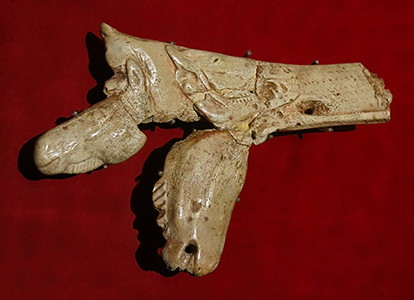
Hooked propulseur, spear thrower, atlatl, from the Middle Magdalenian of la grotte du Mas-d'Azil, in reindeer antler..
One round perforation, another elongated.
Fine lines, asymmetrical V incision, of medium depth. Fragment of a spear thrower, whose blunt hook is still visible. The object was shortened in the Magdalenian period, as shown by the cutting marks on the end opposite the heads and thus lost its hunting weapon function. Two perforations suggest that it could be suspended. On both sides, the decor is very rich and the complex technique combines sculpture in high and low relief as well as simple engraving.
The arrangement and relative size of the horse heads have been suggested by the original form of the reindeer antler; they are located at the beginning of antlers and completed in the round with almost no flattening as a result of the restrictions of the medium. On the shaft, the rest of the decoration appears only in low relief or as engraving. The two heads are very similar and the modelling (muscles, bony prominences) is expressed with great sensitivity.
A series of fine incisions cover the surface, highlighting the beards and manes. The largest head shows its teeth, in an expression that recalls 'the neighing horse'. A deep incision in the form of an angular sign marks the jaw. The neckline, carved on one side of the shaft and summarily interrupted, depicts a cut off head and thus a dead animal.
This hypothesis is reinforced by the presence of an isolated limb and especially, on the other side, by a third horse's head, in the state of a corpse; indeed, the teeth and the jawbone, well in evidence, just as the eye is reduced to a slit, prove that the skin has disappeared; the animal is either skinned or decomposed. This spearthrower provides an extraordinary example of adaptation of decor to the function of a tool or a weapon.
It may be a status object.
Length 165 mm, width 90 mm, thickness 17 mm.
Catalog: 47080
Photo: Don Hitchcock 2015
Source: Original, La Salle Piette, Musée d'Archeologie Nationale et Domaine, St-Germain-en-Laye
Text: © Saint-Germain-en-Laye, musée des antiquités nationales, © Direction des musées de France, 2000
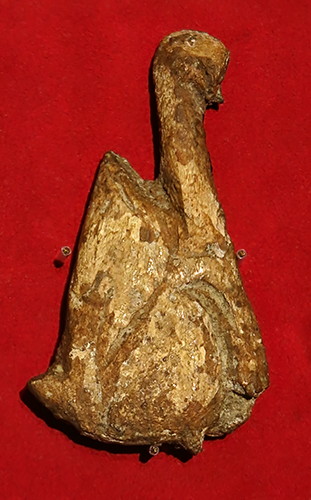
Hooked propulseur, spear thrower, atlatl, from the Middle Magdalenian of la grotte du Mas-d'Azil, in reindeer antler. Known as the swan with three heads.
Engraved using an asymmetric 'v' shape. Sculpted swan, engraved, with head, neck, and wings. Another interpretation of Abbé Breuil is that it is a carved fish, showing the head, the mouth, and the gills.
Length 72 mm, width 39 mm, thickness 12 mm.
Catalog: 47017
Photo: Don Hitchcock 2015
Source: Original, La Salle Piette, Musée d'Archeologie Nationale et Domaine, St-Germain-en-Laye
Text: © Saint-Germain-en-Laye, musée des antiquités nationales, © Direction des musées de France, 2000

Fragment of a propulseur, a spear thrower, from the Middle Magdalenian of le Mas-d'Azil, in reindeer antler.
Carved and engraved animal head, with a round eye, ear, muzzle, and nostril. Abbé Breuil believed that it could be a fox.
Length 32 mm, width 12 mm, thickness 8 mm.
Catalog: 47255
Photo: Don Hitchcock 2015
Source: Original, La Salle Piette, Musée d'Archeologie Nationale et Domaine, St-Germain-en-Laye
Text: © Saint-Germain-en-Laye, musée des antiquités nationales, © Direction des musées de France, 2002

Rondelle from the Middle Magdalenian of la grotte du Mas-d'Azil, on a scapula.
The rondelle is distinguished by the use of notches. On one side, an anthropomorph has been engraved, in left profile, walking, with a round skull, an eye, ear, chin, and two arms, one of which seems to carry a stick. The outline of the body is emphasised by small parallel lines probably representing the hairs, the penis is shown erect, the two feet are separated. To his left is a bear paw with claws.
On the other side is another anthropomorph, standing with arms outstretched, the round skull filled with parallel lines. Superimposed, in the transverse direction, is an engraved horse, in right profile, standing, almost complete, of which we can clearly see the neckline with the mane, the head with the ear, the snout, the posterior part of the horse's lower jaw, the two forelegs, the belly, a hind paw and the well-defined cervico-dorsal line. A bear's paw is arranged in the same way as on the other side, with the coat and the claws. A hatched band crosses part of this surface of the rondelle.
Medium asymetrical 'v' incision, deep asymetrical 'v' incision, and fine incision.
Length 78 mm, width 37 mm, thickness 3 mm.
Catalog: 48120
Photo: Don Hitchcock 2015
Source: Original, La Salle Piette, Musée d'Archeologie Nationale et Domaine, St-Germain-en-Laye
Text: © Saint-Germain-en-Laye, musée des antiquités nationales, © Direction des musées de France, 2003
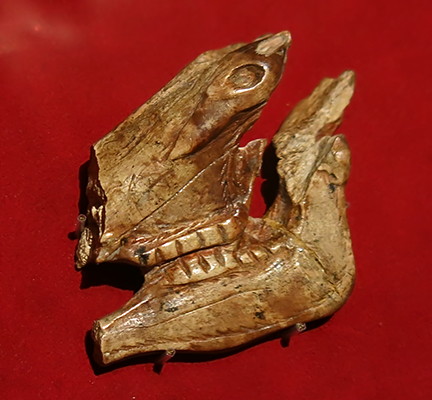
Statuette from la grotte du Mas-d'Azil.
The statuette has been dyed with a mixture of haematite and feldspar. The head of the horse has been shown skinned, defleshed, and the skull, the eye socket, the cheek, jaw, teeth and back of the jaw are shown. The position of the eye socket and the volume of the skull are well represented. Engraved lines underline the contours and hollows, and are accompanied by a barely visible geometric decoration of zigzag lines. The engraved lines are in an asymmetric 'v' shape.
Length 72 mm, width 53 mm, thickness 27 mm.
Catalog: 47026
Photo: Don Hitchcock 2015
Source: Original, La Salle Piette, Musée d'Archeologie Nationale et Domaine, St-Germain-en-Laye
Text: © Saint-Germain-en-Laye, musée des antiquités nationales, © Direction des musées de France, 2000
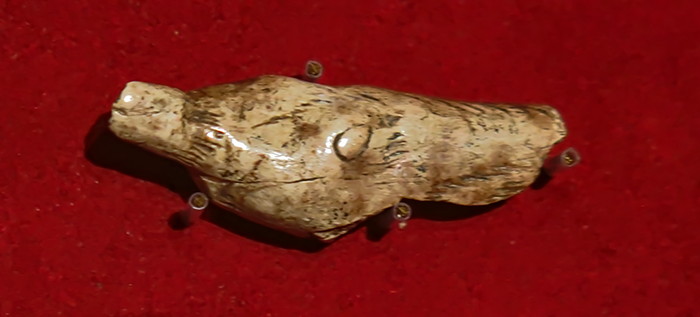
Statuette of the head of a horse, from la grotte du Mas-d'Azil, Middle Magdalenian, in reindeer antler.
Fine incision, in an asymmetric 'v'.
Length 40 mm, width 14 mm, thickness 12 mm.
Catalog: 47021
Photo: Don Hitchcock 2015
Source: Original, La Salle Piette, Musée d'Archeologie Nationale et Domaine, St-Germain-en-Laye
Text: © Saint-Germain-en-Laye, musée des antiquités nationales, © Direction des musées de France, 2000

Propulseur, atlatl, spear thrower, of the head of a horse, from la grotte du Mas-d'Azil, Middle Magdalenian, in reindeer antler.
Known as 'the neighing horse'. Coloured with a mixture of haematite and feldspar.
This sculpture represents a horse's head in the act of 'neighing'. It is likely that it is a fragment belonging to a larger object, a spear thrower or pierced baton. Numerous anatomical details are represented on the left profile, including the orbit, muzzle, nostril, open mouth, and ear. Interlocking chevrons and parallel lines outline the contours and hollows.
The engravings are of a deep symmetrical 'v' incision, deep asymmetrical 'v' incision, and fine incision.
Length 54 mm, width 29 mm, thickness 13 mm.
Catalog: 47343
Photo: Don Hitchcock 2015
Source: Original, La Salle Piette, Musée d'Archeologie Nationale et Domaine, St-Germain-en-Laye
Text: © Saint-Germain-en-Laye, musée des antiquités nationales, © Direction des musées de France, 2002
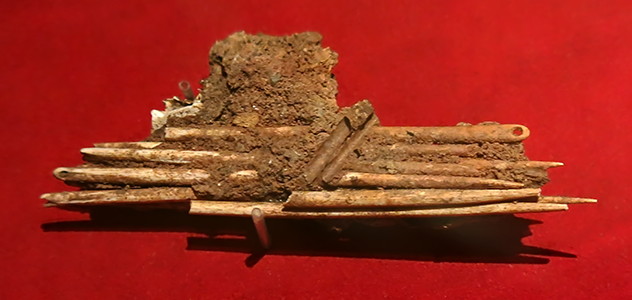
Cluster of eyed needles as found during excavation, from la grotte du Mas-d'Azil, Magdalenian.
In bone, in the bed containing engravings but lacking harpoons.
Catalog: 48807
Photo: Don Hitchcock 2015
Source: Original, La Salle Piette, Musée d'Archeologie Nationale et Domaine, St-Germain-en-Laye
Text: © Saint-Germain-en-Laye, musée des antiquités nationales, © Direction des musées de France, 2004
Baguette demi-ronde, from la grotte du Mas-d'Azil, Middle Magdalenian, in reindeer antler.
On the upper side, on either side of a longitudinal and median rib, terminated by a chevron, lateral protuberances form unequal small rounded projections.
Length 91 mm, width 19 mm, thickness 9 mm.
Catalog: 47398
Photo: Don Hitchcock 2015
Source: Original, La Salle Piette, Musée d'Archeologie Nationale et Domaine, St-Germain-en-Laye
Text: © Saint-Germain-en-Laye, musée des antiquités nationales, © Direction des musées de France, 2002
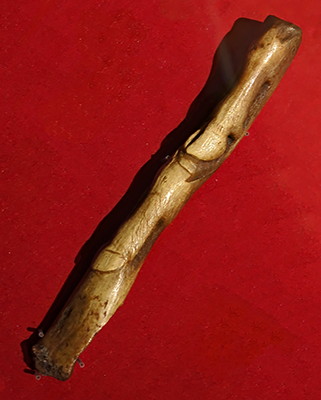
Pierced baton, from la grotte du Mas-d'Azil, Middle Magdalenian, in reindeer antler.
The object is identifiable as a pierced baton by the retention of a small part of the circumference of the hole.
The piece consists of two bison legs sculpted and engraved, with the ergot (small horny protuberance on the back of each of the fetlocks), the pastern, and the cloven hoof clearly visible. The coat of the upper limb is much less abundant than that of the lower limb. This may be an indication of seasonal variation in buffalo coat in summer and winter.
Length 166 mm, width 18 mm, thickness 15 mm.
Catalog: 47341
Photo: Don Hitchcock 2015
Source: Original, La Salle Piette, Musée d'Archeologie Nationale et Domaine, St-Germain-en-Laye
Text: © Saint-Germain-en-Laye, musée des antiquités nationales, © Direction des musées de France, 2002
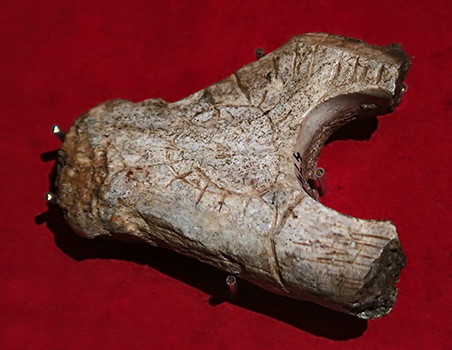
Pierced baton, bâton percé, from la grotte du Mas-d'Azil, Upper Magdalenian, in reindeer antler, known as 'Soleil'.
On one side, in the centre, a large irregular circle with a central incision and outer rays, and on one edge, aligned notches. On the other side a small offset circle, with internal rays and a central incision. Incisions are in a 'v' shape.
Length 61 mm, width 45 mm.
Catalog: 47436
Photo: Don Hitchcock 2015
Source: Original, La Salle Piette, Musée d'Archeologie Nationale et Domaine, St-Germain-en-Laye
Text: © Saint-Germain-en-Laye, musée des antiquités nationales, © Direction des musées de France, 2002
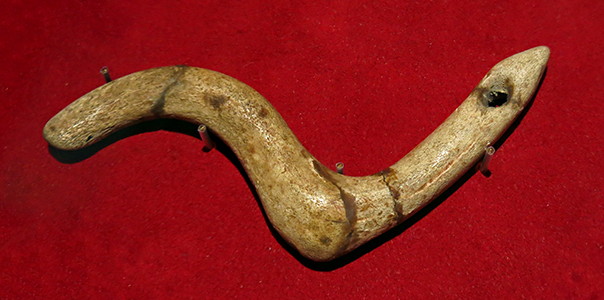
Snake of reindeer antler, with a suspension hole. The tail is rounded, like that of the orvets.
Photo: Don Hitchcock 2015
Source: Original, La Salle Piette, Musée d'Archeologie Nationale et Domaine, St-Germain-en-Laye
Text: Piette (1907)
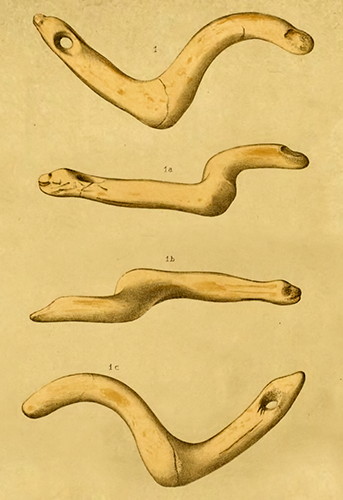
Orvets are lizards that, because of their burrowing lifestyle, have become legless.
They grow from 30 to 130 cm long depending on the species and hunt on the ground, and sometimes under the ground, small animals of suitable size, mainly invertebrates such as arthropods, gastropods, and larvae. They prefer warm conditions.
Photo: Piette (1907)
Text: https://fr.wikipedia.org/wiki/Orvet
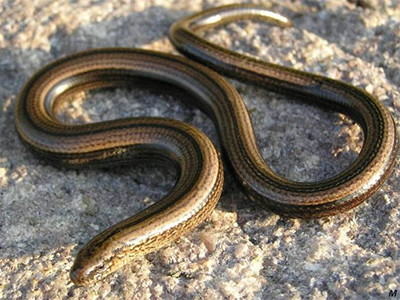
The orvet Anguis fragilis - Common worm or fragile worm, widely distributed in Europe.
Photo: pl:user:Marek_bydg (Olympus C-765).
Permission: GNU Free Documentation License, Version 1.2 or any later version.
Text: Wikipedia

Magdalenian amulet or pendant of reindeer antler from the upper chamber of Mas d'Azil.
The piece has a bulge at one end with a fractured perforation at the other, and is of ovoid shape.
Dimensions: Length 31 mm, width 18 mm, thickness 13 mm.
Catalog: 47032
Photo: Don Hitchcock 2015
Source: Original, La Salle Piette, Musée d'Archeologie Nationale et Domaine, St-Germain-en-Laye
Text: Piette (1907)
Additional text: © Saint-Germain-en-Laye, musée des antiquités nationales, © Direction des musées de France, 2002
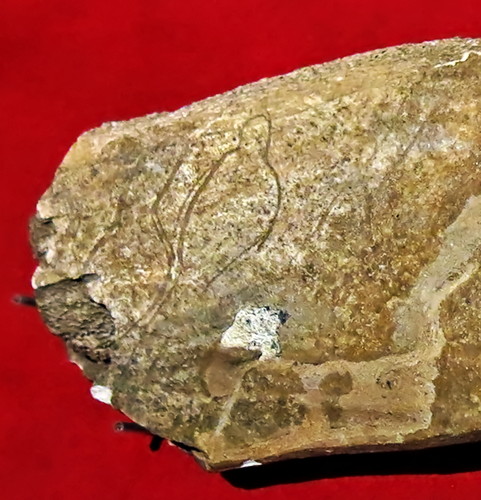
Lalinde venus engraving on reindeer antler.
From the middle Magdalenian of Mas d'Azil, left bank, the 'reindeer layer'.
On one side, three schematisations of human silhouettes and a probable fraction of a fourth along the fracture. They are whole, partial or fractured. On the other side, oblique lines.
Dimensions 190 x 57 x 19 mm.
Catalog: 47527
Photo: Don Hitchcock 2015
Source: Original, La Salle Piette, Musée d'Archeologie Nationale et Domaine, St-Germain-en-Laye
Text: © Saint-Germain-en-Laye, musée des antiquités nationales, © Direction des musées de France, 2002
Engraving on bone, representing equine heads with halters, from the upstream cavern of the right bank of la grotte du Mas-d'Azil.
Photo: Don Hitchcock 2015
Source: Original, La Salle Piette, Musée d'Archeologie Nationale et Domaine, St-Germain-en-Laye
Text: Piette (1907)
Engraving on bone. Sometimes the artisan just put a series of different styles of sets of parallel lines on the piece, for no other purpose but decoration.
Photo: Don Hitchcock 2015
Source: Original, La Salle Piette, Musée d'Archeologie Nationale et Domaine, St-Germain-en-Laye

.... and sometimes the artisan put such a welter of lines on the piece that it is impossible to see an underlying pattern!
Photo: Don Hitchcock 2015
Source: Original, La Salle Piette, Musée d'Archeologie Nationale et Domaine, St-Germain-en-Laye
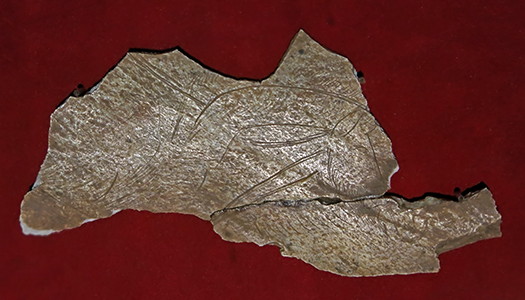

Here can be discerned, on the right, the head and neck of a horse, with ears, eye, neck, forehead, and beard evident.
From the Middle Magdalenian of Le Mas d'Azil.
Two horses engraved in right profile. For one of them, only the mane remains, one end of the snout and the lower jaw which is confused with that of the second, more discernible horse included with this one.
The chest and part of the ventral line are visible. The outline is fully hatched. The second horse is therefore included in the first, and is smaller, always in profile: right, the mane is under that of the first horse, the lower jaw is above the lower jaw of the first horse, the outline of the neck and breast are engraved with a continuous line, the two ears are erect, the muzzle is fractured, the eye is enclosed in a circumflex accent.
Dimensions: Length 130 mm, width 65 mm, thickness 3 mm.
Catalog: 47780
Photo (left): Don Hitchcock 2015
Photo (right): © Saint-Germain-en-Laye, musée des antiquités nationales, © Direction des musées de France, 2002
Source: Original, La Salle Piette, Musée d'Archeologie Nationale et Domaine, St-Germain-en-Laye
Text: © Saint-Germain-en-Laye, musée des antiquités nationales, © Direction des musées de France, 2002
Tree (or plant) engraved on reindeer antler, showing branches and roots. At either end of the piece are rows of parallel lines, alternating with other rows of lines that are directed in the opposite direction, forming zig-zags.
From the lower gallery of the upstream cavern on the right bank of the river Arise which flows through Mas-d'Azil.
Catalog: 45639 (?)
Photo: Don Hitchcock 2015
Source: Original, La Salle Piette, Musée d'Archeologie Nationale et Domaine, St-Germain-en-Laye
Text: Piette (1907)
Pendant from a rib bone, Upper Magdalenian from Layer V, Lortet, Hautes-Pyrénées.
The pendant has been waisted at one end to aid suspension as a necklace/pendant. On one side, two very classic representations of stylized ibex, seen from the front, with the body, the head, and the schematised horns.
The lower ibex body has two oblique features. Below the ibexes is a spindle pattern.
Dimensions: Length 73 mm, width 35 mm, thickness 10 mm.
Catalog: 48213
Photo: Don Hitchcock 2015
Source: Original, La Salle Piette, Musée d'Archeologie Nationale et Domaine, St-Germain-en-Laye
Additional text: © Saint-Germain-en-Laye, musée des antiquités nationales, © Direction des musées de France, 2004
Spatula, reindeer antler, Magdalenian, from Layer V, Lortet in the Hautes-Pyrénées.
Enigmatic decor. On either side of a midrib, irregular oblique lines. The other side is streaked with longitudinal lines framing a slight median relief.
Dimensions: Length 63 mm, width 12 mm, thickness 6 mm.
Catalog: 48212
Photo: Don Hitchcock 2015
Source: Original, La Salle Piette, Musée d'Archeologie Nationale et Domaine, St-Germain-en-Laye
Text: © Saint-Germain-en-Laye, musée des antiquités nationales, © Direction des musées de France, 2003
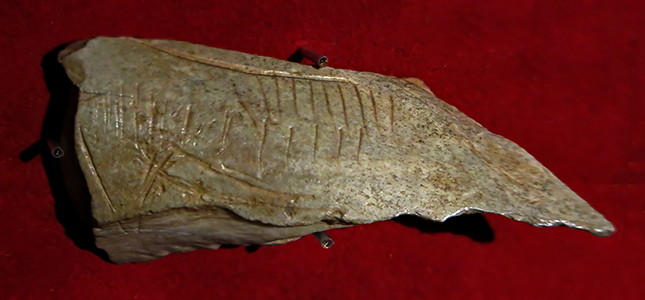
Découpé image of a deer from the Upper Magdalenian of Lortet in the Hautes-Pyrénées, Layer V.
Body découpé and engraved with a cervid, showing the right profile, on one face: fractured tail, rump découpé, dorsal line, hind hoof, flank covered with bands of parallel lines, ventral line, line of the chest.
Dimensions: Length 77 mm, width 33 mm, thickness 7 mm.
Catalog: 48199
Photo: Don Hitchcock 2015
Source: Original, La Salle Piette, Musée d'Archeologie Nationale et Domaine, St-Germain-en-Laye
Text: © Saint-Germain-en-Laye, musée des antiquités nationales, © Direction des musées de France, 2003
Bone or antler on which has been engraved a series of chevrons.
Photo: Don Hitchcock 2015
Source: Original, La Salle Piette, Musée d'Archeologie Nationale et Domaine, St-Germain-en-Laye
Text: Piette (1907)
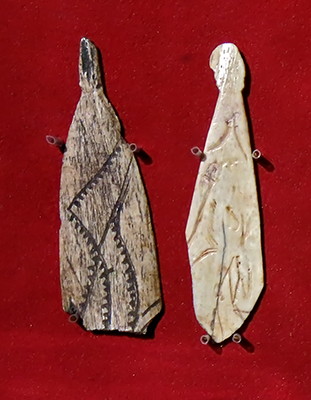
(left) Fragment of an ornamental pendant from the Upper Magdalenian, completed in reindeer antler, the engravings enhanced by dark colourisation, possibly manganese dioxide.
On one face, sinuous pectinated (comb like) intertwined lines.
Dimensions: Length 60 mm, width 20 mm, thickness 2 mm.
Catalog: 48762
Additional text: © Saint-Germain-en-Laye, musée des antiquités nationales, © Direction des musées de France, 2004
(right) Pendant, engraved bone, from the Upper Magdalenian of Lortet.
On the flat side, above, a deer head has been engraved. Left profile, with an ear, almond shaped eye, a cheek underlined by parallel striations, a muzzle, nostril, shown with the mouth ajar, and the neck. In front of the deer is an angular pattern.
Length 59 mm, width 16 mm, thickness 2 mm.
Catalog: 47349
Photo: Don Hitchcock 2015
Source: Original, La Salle Piette, Musée d'Archeologie Nationale et Domaine, St-Germain-en-Laye
Text: Piette (1907)
Additional text: © Saint-Germain-en-Laye, musée des antiquités nationales, © Direction des musées de France, 2002
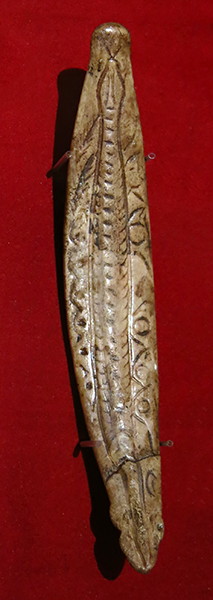
Pendant of reindeer antler, Middle Magdalenian from Lortet.
On the upper side, a snake engraved in the centre of the piece. It has a well drawn head, and a body with transverse parallel incisions. On each side, decorations made of aligned broken lines, scrolls, circles or points. The piece itself has the shape of a snake's body engraved, with a carved head, eye and mouth. On the underside, there is a double broken line along one edge, and oblique curved lines aligned along the other edge.
Length 138 mm, width 25 mm, thickness 8 mm.
Catalog: 47418
Photo: Don Hitchcock 2015
Source: Original, La Salle Piette, Musée d'Archeologie Nationale et Domaine, St-Germain-en-Laye
Text: © Saint-Germain-en-Laye, musée des antiquités nationales, © Direction des musées de France, 2002

Pendant with a pronounced medial rib, in reindeer antler, from the Middle Magdalenian of Lortet.
An embossed medial rib decorates the piece, denoting, perhaps, the body of a snake. One of the very thin ends in the shape of a suspension knob may be the head of the animal.
Length 116 mm, width 19 mm, thickness 10 mm.
Catalog: 48345
Photo: Don Hitchcock 2015
Source: Original, La Salle Piette, Musée d'Archeologie Nationale et Domaine, St-Germain-en-Laye
Text: © Saint-Germain-en-Laye, musée des antiquités nationales, © Direction des musées de France, 2003
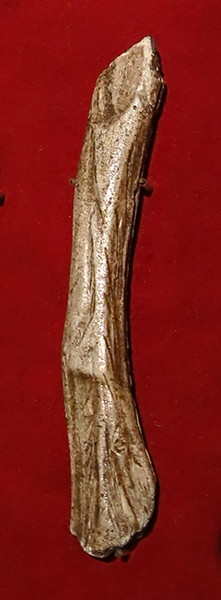
Some see this as a pierced baton. From the Middle Magdalenian of Lortet, in reindeer antler.
On one side, two sinous longitudinal grooves. On the other side, two weakly curved grooves delimit a flat surface bearing parallel streaks and another curved groove.
Length 102 mm, width 20 mm, thickness 9 mm.
Catalog: 48416 A
Photo: Don Hitchcock 2015
Source: Original, La Salle Piette, Musée d'Archeologie Nationale et Domaine, St-Germain-en-Laye
Text: © Saint-Germain-en-Laye, musée des antiquités nationales, © Direction des musées de France, 2003
( note that in order to display the engraving to the best advantage I have rotated the image 180°, upside down compared to the way it was displayed in the glass cabinet. I have also used, to a limited extent, false colour in order for the engraving to be more easily discerned - Don )
Engraved bone, Middle Magdalenian from Lortet in the Hautes-Pyrénées.
Two horses have been engraved, superimposed, in opposite directions.
The first horse, much easier to make out, is engraved in left profile, and has a disproportionate body. The head and the neck are very important compared to the smallness of the legs. The snout is intersected by the hindquarters of the second horse but the mouth is visible, the lower jaw is represented as well as the erect mane; the dorsal line and the ventral line are interrupted by the break. In the opposite direction, a second horse, left profile ( if you have the eye of faith! - Don ). The head is fractured, the lower jaw is present as well as the neck, the erect mane, the dorsal line, the ventral line, the legs which cut the head of the previous horse, the hindquarters, and the fractured tail.
Dimensions: Length 127 mm, width 75 mm, thickness 14 mm.
Catalog: 48600
Photo: Don Hitchcock 2015
Source: Original, La Salle Piette, Musée d'Archeologie Nationale et Domaine, St-Germain-en-Laye
Text: © Saint-Germain-en-Laye, musée des antiquités nationales, © Direction des musées de France, 2003

Engraved reindeer antler from the Upper Magdalenian of Lortet in the Hautes-Pyrénées.
Incomplete decoration at the pointed end: on one side, several spindles in slight relief, four oblique cuts; on the other side, two ellipses, one of which is incomplete and the other bearing an inner ellipse. Below, a longitudinal line and irregular oblique streaks. Part of the shaft has been hammered.
Dimensions: Length 200 mm, width 27 mm, thickness 20 mm.
Catalog: 48215
Photo: Don Hitchcock 2015
Source: Original, La Salle Piette, Musée d'Archeologie Nationale et Domaine, St-Germain-en-Laye
Text: © Saint-Germain-en-Laye, musée des antiquités nationales, © Direction des musées de France, 2003

(left) Fragment of a pendant, in flat bone, of which not much more remains than the part where the suspension hole was made.
From the Magdalenian of Lortet, Layer IV-V, in bone.
The piece is decorated with a series of short and very wide parallel transverse grooves.
Length 30 mm, width 10 mm, thickness 3 mm
Catalog: 48393
(right) Fragment of an ivory pendant, decorated with three strips of geometric design, from the Upper Magdalenian of Lortet.
Three horizontal lines like the teeth of a comb, slightly undulating. Polished, with a red colour from ochre.
Length 26 mm, width 10 mm, thickness 4 mm
Catalog: 47424 B
Photo: Don Hitchcock 2015
Source: Original, La Salle Piette, Musée d'Archeologie Nationale et Domaine, St-Germain-en-Laye
Text: Piette (1907)
Additional text: © Saint-Germain-en-Laye, musée des antiquités nationales, © Direction des musées de France, 2002/3
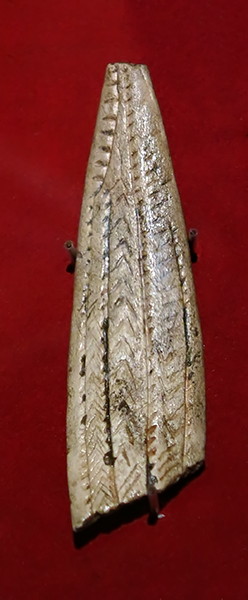
Pendant from the Middle Magdalenian from Lortet, in reindeer antler.
The entire upper face is covered with a decoration composed of interlocking chevrons and oblique striations, separated by longitudinal grooves. On the other side, the edges bear on one side aligned chevrons, on the other side a lattice pattern.
Length 83 mm, width 24 mm, thickness 7 mm.
Catalog: 47412
Photo: Don Hitchcock 2015
Source: Original, La Salle Piette, Musée d'Archeologie Nationale et Domaine, St-Germain-en-Laye
Text: © Saint-Germain-en-Laye, musée des antiquités nationales, © Direction des musées de France, 2002
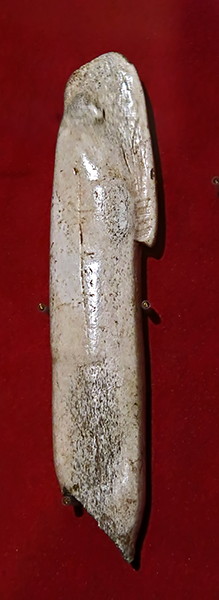
Part of a spear thrower, from the Middle Magdalenian of Gourdan, Layer V, in bone.
It may depict a schematic animal head.
Length 90 mm, width 20 mm.
Catalog: 49164
Photo: Don Hitchcock 2015
Source: Original, La Salle Piette, Musée d'Archeologie Nationale et Domaine, St-Germain-en-Laye
Text: © Saint-Germain-en-Laye, musée des antiquités nationales, © Direction des musées de France, 2004

Part of a spear thrower, from the Middle Magdalenian of Gourdan, Layer IV-V, in bone.
Catalog: 48627
Photo: Don Hitchcock 2015
Source: Original, La Salle Piette, Musée d'Archeologie Nationale et Domaine, St-Germain-en-Laye
Text: © Saint-Germain-en-Laye, musée des antiquités nationales, © Direction des musées de France, 2003
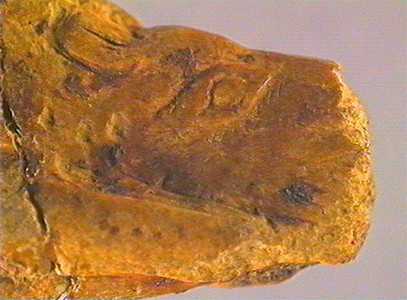
(part of the propulseur above)
The head of a bison has been carved and engraved on both sides. The head is well detailed, with the ear and the eye in relief, the forehead, the muzzle, the nose, and the mouth. We also distinguish the loins, the front legs and the hind legs.
Length 90 mm, width 30 mm.
Catalog: 48627
Source: Original, La Salle Piette, Musée d'Archeologie Nationale et Domaine, St-Germain-en-Laye
Photo and text: © Saint-Germain-en-Laye, musée des antiquités nationales, © Direction des musées de France, 2003
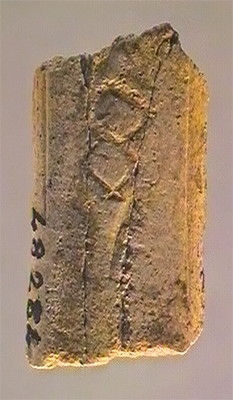
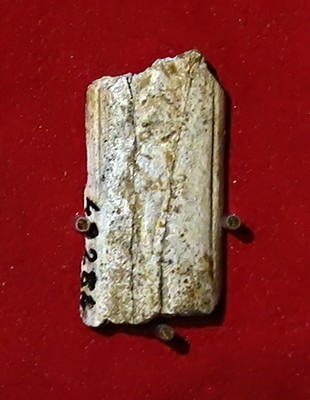
Ornament in reindeer antler decorated with geometric forms, from the Magdalenian of Lortet.
On one side, a figure composed of two joined rhombuses joined, framed by two chevrons, of which one is broken. On each edge, a longitudinal groove has been engraved.
Length 30 mm, width 15 mm, thickness 5 mm.
Catalog: 48284
Photo (left): © Saint-Germain-en-Laye, musée des antiquités nationales, © Direction des musées de France, 2003
Photo (right): Don Hitchcock 2015
Source: Original, La Salle Piette, Musée d'Archeologie Nationale et Domaine, St-Germain-en-Laye
Text: © Saint-Germain-en-Laye, musée des antiquités nationales, © Direction des musées de France, 2003

Pierced baton, bâton percé, from Lortet, layer V, Magdalenian, in reindeer antler.
Each face has transverse grooves, seven on one side and three on the other. The edges of the shaft are framed by longitudinal grooves. The upper end carries a transverse groove. Incisions in 'v' shape.
Length 68 mm, width 38 mm, thickness 11 mm.
Catalog: 48214
Photo: Don Hitchcock 2015
Source: Original, La Salle Piette, Musée d'Archeologie Nationale et Domaine, St-Germain-en-Laye
Text: © Saint-Germain-en-Laye, musée des antiquités nationales, © Direction des musées de France, 2003

Magdalenian pierced baton in three pieces, two of which are shown in this image, from Lortet, layer V, in reindeer antler.
Geometric decoration using wide grooves, in champlevé style. On one side: oblique rows of irregular fused spindles and some slight concentric reliefs on both sides of the hole. On a ridge, long interlocking chevrons. On the other side, an oblique groove is confined by two rows of adjoining chevrons, opposed by their bases. The end carries arcs in slight relief. Fine oblique streaks around the perforation. The 48230 fragment is composed of contiguous spindles.
The baton consists of three fragments of the same pierced baton, two of which bear the same number and were previously glued together.
Length 90 mm, width 29 mm, thickness 15 mm.
Catalog: 48211, 48230
Photo: Don Hitchcock 2015
Source: Original, La Salle Piette, Musée d'Archeologie Nationale et Domaine, St-Germain-en-Laye
Text: © Saint-Germain-en-Laye, musée des antiquités nationales, © Direction des musées de France, 2003
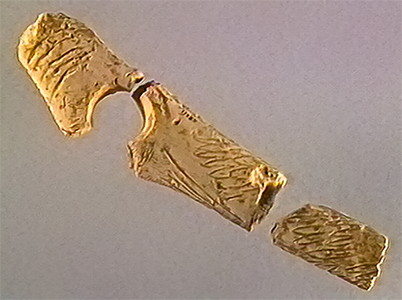
Magdalenian pierced baton in three pieces, from Lortet, layer V, in reindeer antler, as in the image above.
The baton consists of three fragments of the same pierced baton, two of which bear the same number and were previously glued together.
Catalog: 48211, 48230
Photo: © Saint-Germain-en-Laye, musée des antiquités nationales, © Direction des musées de France, 2003
Source: Original, La Salle Piette, Musée d'Archeologie Nationale et Domaine, St-Germain-en-Laye
Text: © Saint-Germain-en-Laye, musée des antiquités nationales, © Direction des musées de France, 2003
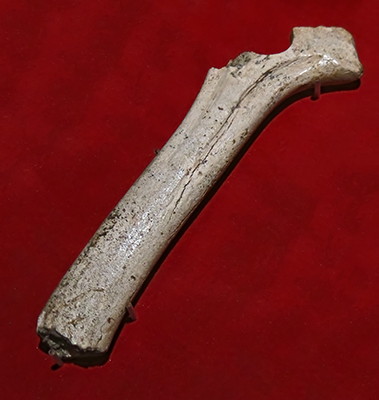
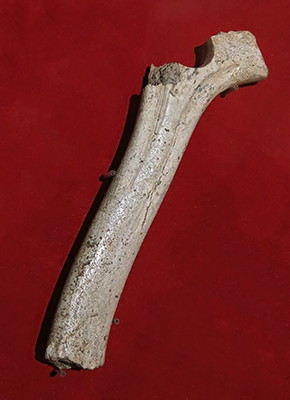
Pierced baton, bâton percé, from Lortet, layer I, Upper Magdalenian, in reindeer antler.
Starting from the perforation, the shaft has a short raised midrib.
Length 119 mm, width 36 mm, thickness 11 mm.
Catalog: 48188
Photo: Don Hitchcock 2015
Source: Original, La Salle Piette, Musée d'Archeologie Nationale et Domaine, St-Germain-en-Laye
Text: © Saint-Germain-en-Laye, musée des antiquités nationales, © Direction des musées de France, 2003
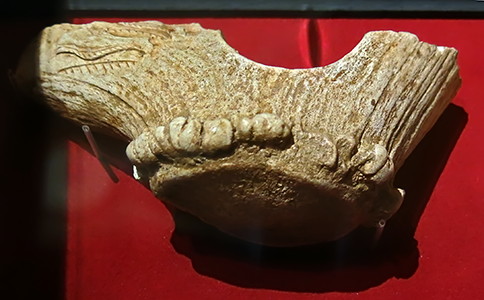
Pierced baton, bâton percé, from Lortet, Upper Palaeolithic, in deer antler.
The piece is carved with difficult to interpret figures: perhaps the legs of an animal in low relief, bordered with ribbed lines.
Length 122 mm, width 56 mm, thickness 53 mm.
Catalog: 47089
Photo: Don Hitchcock 2015
Source: Original, La Salle Piette, Musée d'Archeologie Nationale et Domaine, St-Germain-en-Laye
Text: © Saint-Germain-en-Laye, musée des antiquités nationales, © Direction des musées de France, 2000
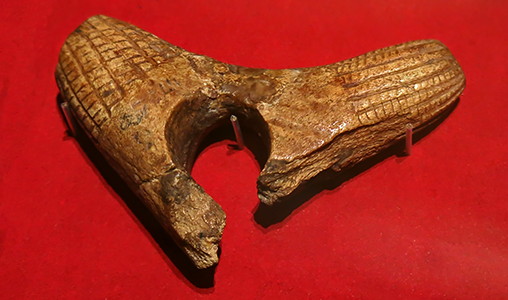
Pierced baton, bâton percé, from la Grotte de Mas-d'Azil, Middle Magdalenian, in reindeer antler from Layer I on the right bank.
On both branches and on both sides are parallel grooves, oblique, transversely striated, delineating small tubercles and forming a sort of grid. On one branch is a trace of wear. Breuil thought it could be an imitation of basketry.
Length 100 mm, width 60 mm, thickness 21 mm.
Catalog: 47250
Photo: Don Hitchcock 2015
Source: Original, La Salle Piette, Musée d'Archeologie Nationale et Domaine, St-Germain-en-Laye
Text: © Saint-Germain-en-Laye, musée des antiquités nationales, © Direction des musées de France, 2000
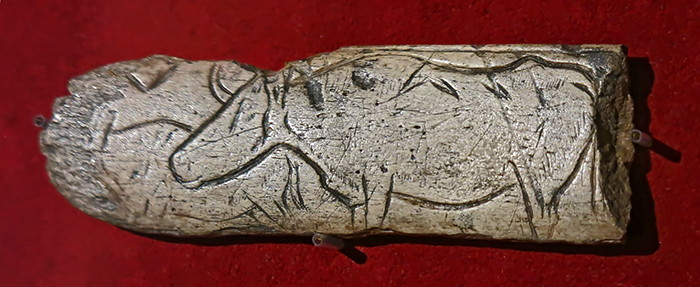
Lissoir, used to work leather, from la Grotte du Mas-d'Azil, Upper Magdalenian, in bone.
This scene has long been described as a maternity scene. The main animal is a female bovine, left profile, standing, with a curved horn, almond shaped eye, muzzle, nose, mouth, two angular signs on the back, legs, and a dewlap. A smaller animal precedes it. A perspective effect makes the smaller animal appear further back.
Because of its size, it was thought that this smaller animal was a calf. But it would be better to see in this composition, an example of perspective by partial superposition. The head of this second bovine is not visible. The animal is in a walking posture, The two animals are quite similar: withers, the line of the back, the long tail. Above the smaller animal is an angular pattern.
Length 82 mm, width 26 mm, thickness 6 mm.
Catalog: 47358
Photo: Don Hitchcock 2015
Source: Original, La Salle Piette, Musée d'Archeologie Nationale et Domaine, St-Germain-en-Laye
Text: © Saint-Germain-en-Laye, musée des antiquités nationales, © Direction des musées de France, 2002
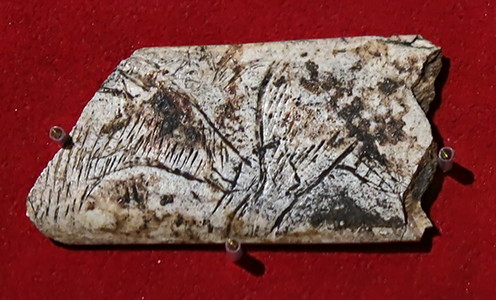
Engraved bone from Lortet, Middle Magdalenian.
On one side, two animals are engraved in file, in right profile. On the left, the forequarters of an ibex with annular ringed horn, probably with ears, barely visible eye, muzzle, nostril, mouth, and chest. The body is covered with fur in hatched strips. In front of the ibex, there is another animal whose only distinguishing feature is the hindquarters, with the rump, the spread tail, the beginning of the ventral line, the two hind legs and a coat in hatched bands.
On the other side, are two indeterminable animals (because they are too fragmentary), arranged facing in opposite directions. From the first, only a fragment of the right profile head remains with the oval eye, the snout, the underlined and delimited cheek. In the opposite direction, the second animal is in left profile. What remains are the hindquarters with the rump, the tail, the two hind legs, and the coat in hatched bands.
Length 43 mm, width 21 mm, thickness 35 mm.
Catalog: 48205
Photo: Don Hitchcock 2015
Source: Original, La Salle Piette, Musée d'Archeologie Nationale et Domaine, St-Germain-en-Laye
Text: © Saint-Germain-en-Laye, musée des antiquités nationales, © Direction des musées de France, 2003
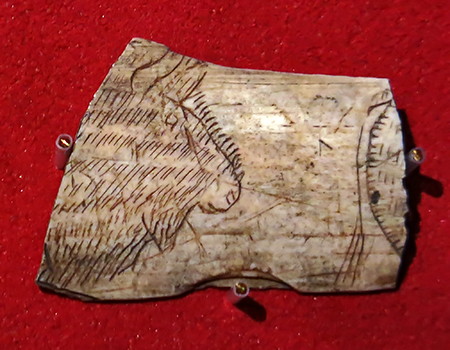
Engraved bone from Lortet, Layer V, Magdalenian.
On the upper part, a bovine head is engraved. The head remains, part of the S-shaped horns, possibly a broken ear and part of the chest. The animal is covered with a very dense coat in hatched bands including the chanfrein (the area between the forehead and the nostrils). The eye is visible, quadrangular, the nose is geometric, the mouth is drawn. Facing this bovine, is the rear of an indeterminate animal with a long tail.
See the piece Catalog 48200 below that could possibly be connected to this piece (same width, same thickness, figures that could be complementary)
Length 35 mm, width 26 mm, thickness 4 mm.
Catalog: 48202
Photo: Don Hitchcock 2015
Source: Original, La Salle Piette, Musée d'Archeologie Nationale et Domaine, St-Germain-en-Laye
Text: © Saint-Germain-en-Laye, musée des antiquités nationales, © Direction des musées de France, 2003
Engraved bone from Lortet, Layer V, Magdalenian.
On one side, the hindquarters of a bovine, engraved in right profile: rump, tail long and hanging, exaggerated dorsal line, engraved with oblique parallel lines, body covered with bands of parallel lines
See the piece Catalog 48202 above that could possibly be connected to this piece (same width, same thickness, figures that could be complementary)
Length 92 mm, width 26 mm, thickness 4 mm.
Catalog: 48200
Photo: Don Hitchcock 2015
Source: Original, La Salle Piette, Musée d'Archeologie Nationale et Domaine, St-Germain-en-Laye
Text: © Saint-Germain-en-Laye, musée des antiquités nationales, © Direction des musées de France, 2003
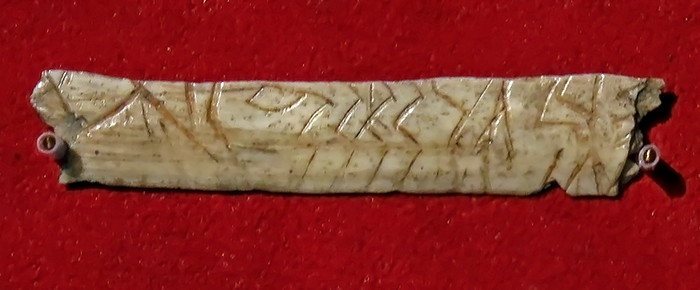
Bone, probably a rib used as a lissoir, with a zig zag design.
Photo: Don Hitchcock 2015
Source: Original, La Salle Piette, Musée d'Archeologie Nationale et Domaine, St-Germain-en-Laye

Rib bone from Lortet, upper Magdalenian, with a pectinated (comb like) design similar to a 'blanket stitch'.
On one side are engraved three closed geometric figures, including a triangle and a quadrilateral. These figures are contiguous and formed of straight lines or pectinated (having narrow ridges or projections aligned close together like the teeth of a comb) curves.
Dimensions: Length 65 mm, width 13 mm, thickness 5 mm.
Catalog: 47424
Photo: Don Hitchcock 2015
Source: Original, La Salle Piette, Musée d'Archeologie Nationale et Domaine, St-Germain-en-Laye
Text: © Saint-Germain-en-Laye, musée des antiquités nationales, © Direction des musées de France, 2002
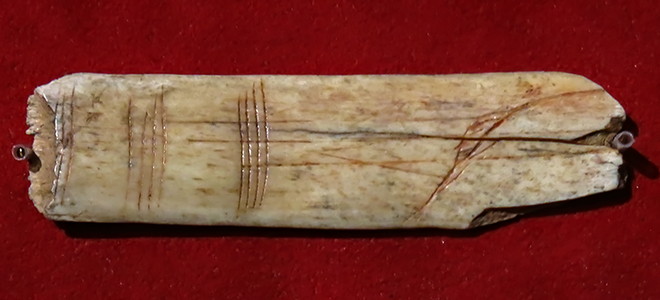
Lissoir made on a rib bone from the Upper Magdalenian, scored with three groups of four parallel lines, and a curved line which may be the rear of an animal.
Dimensions: Length 60 mm, width 16 mm, thickness 3 mm.
Catalog: 48761
Photo: Don Hitchcock 2015
Source: Original, La Salle Piette, Musée d'Archeologie Nationale et Domaine, St-Germain-en-Laye
Text: © Saint-Germain-en-Laye, musée des antiquités nationales, © Direction des musées de France, 2004
Bird bone from the Upper Magdalenian of Lortet showing a frieze of three deer heads engraved in left profile, one at the level of the fracture.
The heads are stretched out, the eyes are very strongly incised showing the lachrymal canal, and the ears and nostrils are well marked.
Above, there is a complex geometric decoration including a closed heart-shaped figure, curved lines and groups of oblique lines.
Dimensions: Length 15 mm, width 13 mm, thickness 11 mm.
Catalog: 47285
Photo (lower and centre): Don Hitchcock 2015
Source: Original, La Salle Piette, Musée d'Archeologie Nationale et Domaine, St-Germain-en-Laye
Text and upper photo: © Saint-Germain-en-Laye, musée des antiquités nationales, © Direction des musées de France, 2002
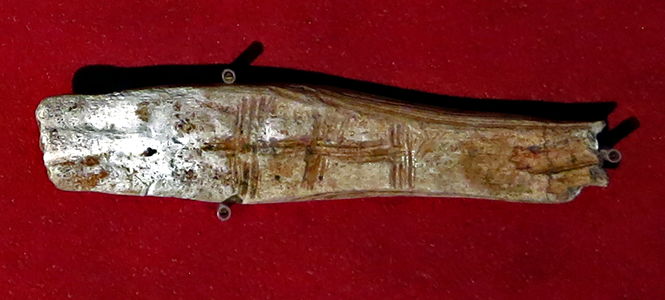
Carved reindeer antler from the Upper Magdalenian of Lortet.
It has decoration including a longitudinal notch, a transverse notch, and transverse grooving. On one side, a large longitudinal and median cut is intersected by three other large transverse cuts of increasing length, forming quadrangular patterns. On the other side, several transverse grooves and an angular pattern.
Dimensions: Length 65 mm, width 14 mm, thickness 7 mm.
Catalog: 48760
Photo: Don Hitchcock 2015
Source: Original, La Salle Piette, Musée d'Archeologie Nationale et Domaine, St-Germain-en-Laye
Text: © Saint-Germain-en-Laye, musée des antiquités nationales, © Direction des musées de France, 2004
Carved bird bone from the Upper Magdalenian of Lortet, Hautes-Pyrénées.
A fractured chamois head reveals a curved horn at its end, an ear and the fur of the forehead. On the right, a circular transverse line. Above, a line of oblique and intersecting lines. More to the right and above, oblique and longitudinal features without apparent organiszation, and nested chevrons. On the extreme right, probably another inderterminate animal figure.
Dimensions: Length 50 mm, width 14 mm, thickness 10 mm.
Catalog: 48228
Photo (left): Don Hitchcock 2015
Source: Original, La Salle Piette, Musée d'Archeologie Nationale et Domaine, St-Germain-en-Laye
Text and photo (right): © Saint-Germain-en-Laye, musée des antiquités nationales, © Direction des musées de France, 2003
Decorated bird bone used as a pendant from the Upper Magdalenian of Arudy, the Atlantic Pyrenees.
Along the bone, a median line separates a row of interlocking chevrons and oblique striae, and a series of oblique and transverse cuts.
Above, two interlocking chevrons.
Dimensions: Length 150 mm, width 8 mm, thickness 6 mm.
Catalog: 47417
Photo: Don Hitchcock 2015
Source: Original, La Salle Piette, Musée d'Archeologie Nationale et Domaine, St-Germain-en-Laye
Text: © Saint-Germain-en-Laye, musée des antiquités nationales, © Direction des musées de France, 2002
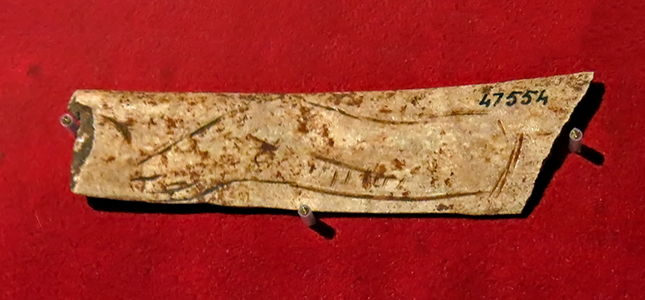 Bone lissoir from the Upper Magdalenian of Mas d'Azil, layer III, right bank.
Bone lissoir from the Upper Magdalenian of Mas d'Azil, layer III, right bank.
Very elongated head and neck of an indeterminate animal, left profile. The neckline is highlighted with a line accompanied by small transverse lines. The eye, the muzzle, the nostril and the mouth are well drawn.
Dimensions: Length 66 mm, width 18 mm, thickness 3 mm.
Catalog: 47554
Photo: Don Hitchcock 2015
Source: Original, La Salle Piette, Musée d'Archeologie Nationale et Domaine, St-Germain-en-Laye
Text: © Saint-Germain-en-Laye, musée des antiquités nationales, © Direction des musées de France, 2002
Engraved bird bone from the Upper Magdalenian of Gourdan-Polignan.
The bone is engraved with several highly stylised pisciform motifs (photograph above), three of which are aligned and one striated transversely. The distal end is embellished with a series of longitudinal grooves.
Dimensions: Length 84 mm, width 14 mm, thickness 10 mm.
Catalog: 48412
Photo (below): Don Hitchcock 2015
Source: Original, La Salle Piette, Musée d'Archeologie Nationale et Domaine, St-Germain-en-Laye
Photo (above): Piette (1907)
Text: © Saint-Germain-en-Laye, musée des antiquités nationales, © Direction des musées de France, 2003

Magdalenian carving from Le Mas-d'Azil in the champlevé style, which imitates sculpture in the round, of the somewhat damaged head and the front leg of a horse in profile on the right, and the hindquarters of a mare whose genital and anal parts are seen from the front and meticulously detailed. Breuil might see there a scene of fertility. Perhaps it is one and the same animal whose body revolves around the bone.
Dimensions: Length 126 mm, width 41 mm, thickness 13 mm.
Catalog: 47035
Photo: Don Hitchcock 2015
Source: Original, La Salle Piette, Musée d'Archeologie Nationale et Domaine, St-Germain-en-Laye
Photo (above): Piette (1907)
Text: © Saint-Germain-en-Laye, musée des antiquités nationales, © Direction des musées de France, 2000
Harpoons from Mas d'Azil
Harpoons from Le Mas-d'Azil.
Many of these harpoons have had the hole of attachment for a cord broken out by hard use, at which point in time they were discarded.
Lying above two layers clearly characteristic of the Magdalenian industry, and separated from them by a stratum of yellow river-ooze, were found the remains of a culture to which Piette gave the name of the Azilian Epoch. Here were found hearths, heaps of iron oxide, numerous bones of deer - but none of reindeer - chipped flints of the Magdalenian type in great abundance, flat and perforated harpoons of stag-antler, bone stilettos and polishers, and broken bones giving evidence of the presence of Stag, Roe-deer, Bear, wild Boar, Beaver, Badger, wild Cat, etc. - De Morgan (1924)Photo: Don Hitchcock 2015
Source: Original, La Salle Piette, Musée d'Archeologie Nationale et Domaine, St-Germain-en-Laye
Text adapted from: De Morgan (1924)
Harpoons from Le Mas-d'Azil. The five harpoons on the right in the upper photo are repeated on the left in the lower photo.
Many of these harpoons have had the hole of attachment for a cord broken out by hard use, at which point in time they were discarded.
Photo: Don Hitchcock 2015
Source: Original, La Salle Piette, Musée d'Archeologie Nationale et Domaine, St-Germain-en-Laye
Harpoons from Le Mas-d'Azil.
Photo: Don Hitchcock 2015
Source: Original, La Salle Piette, Musée d'Archeologie Nationale et Domaine, St-Germain-en-Laye
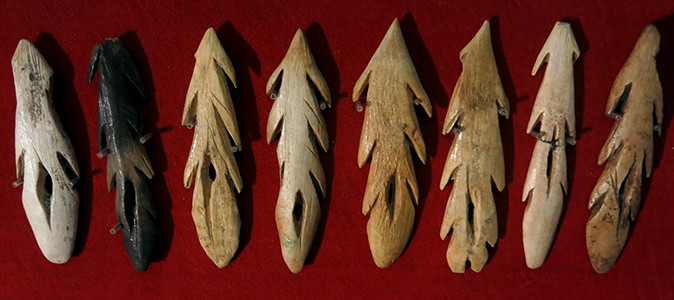
Harpoons from Le Mas-d'Azil.
These harpoons feature complete holes for attachment to a cord, without breakages, although the tips of some have been damaged.
Photo: Don Hitchcock 2015
Source: Original, La Salle Piette, Musée d'Archeologie Nationale et Domaine, St-Germain-en-Laye
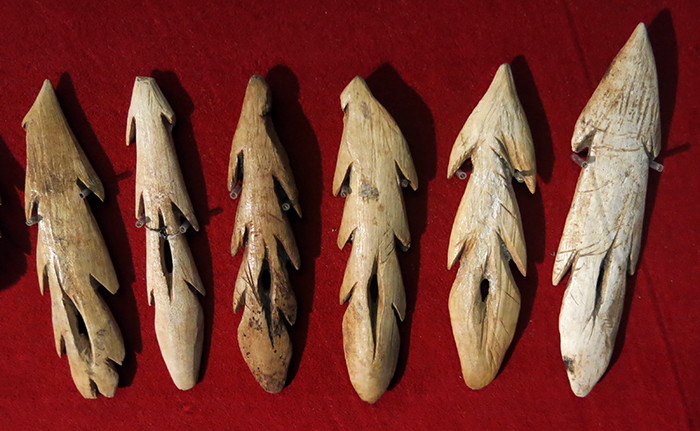
Harpoons from Le Mas-d'Azil.
This is the continuation of the line of harpoons immediately above, with three of them also in this shot.
Photo: Don Hitchcock 2015
Source: Original, La Salle Piette, Musée d'Archeologie Nationale et Domaine, St-Germain-en-Laye
References
- Cleuziou, H.., 1887: La création du monde et les premiers âges de l'humanité, Paris : C. Marpon & C. Flammarion, 1887. Fig. 153.
- De Morgan, J. , 1924: Prehistoric Man (1924): A General Outline of Prehistory, Routledge, 2018 ISBN 1351347039, 9781351347037 Length 324 pages
- Piette, E., 1907: L'Art Pendant l'Age du Renne, Paris, Masson et cie, ed.
Back to Don's Maps
 Back to Archaeological Sites
Back to Archaeological Sites


